Review of Educational Studies and Research Papers
VerifiedAdded on 2020/10/05
|33
|9515
|112
AI Summary
The provided text appears to be a collection of references from various academic journals and books on educational topics. The references cover a range of subjects such as teaching methodologies, teacher training, adult education, and special education administration. Each reference is accompanied by a brief description or context, suggesting that the purpose of this document is to facilitate research or provide background information for students or educators.
Contribute Materials
Your contribution can guide someone’s learning journey. Share your
documents today.
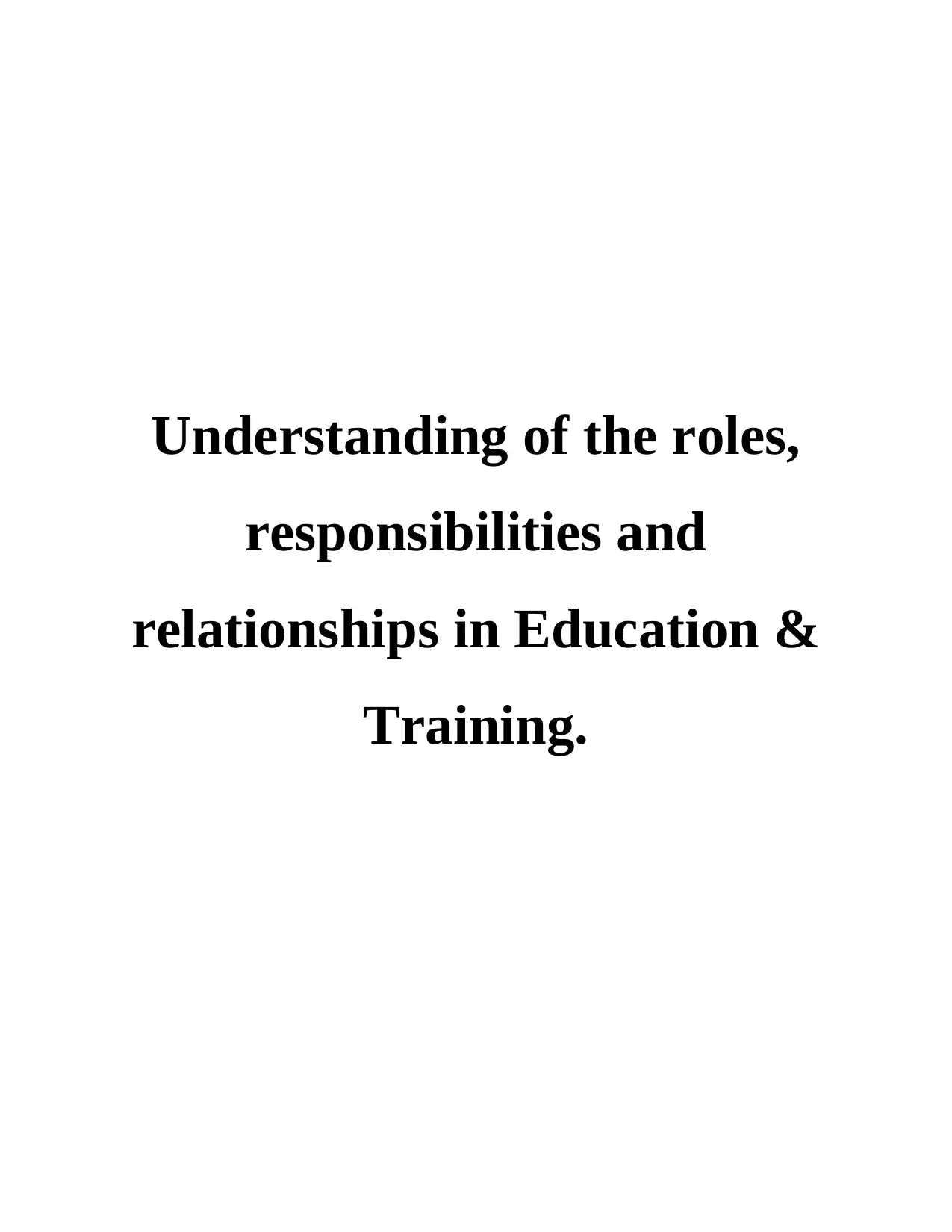
Understanding of the roles,
responsibilities and
relationships in Education &
Training.
responsibilities and
relationships in Education &
Training.
Secure Best Marks with AI Grader
Need help grading? Try our AI Grader for instant feedback on your assignments.
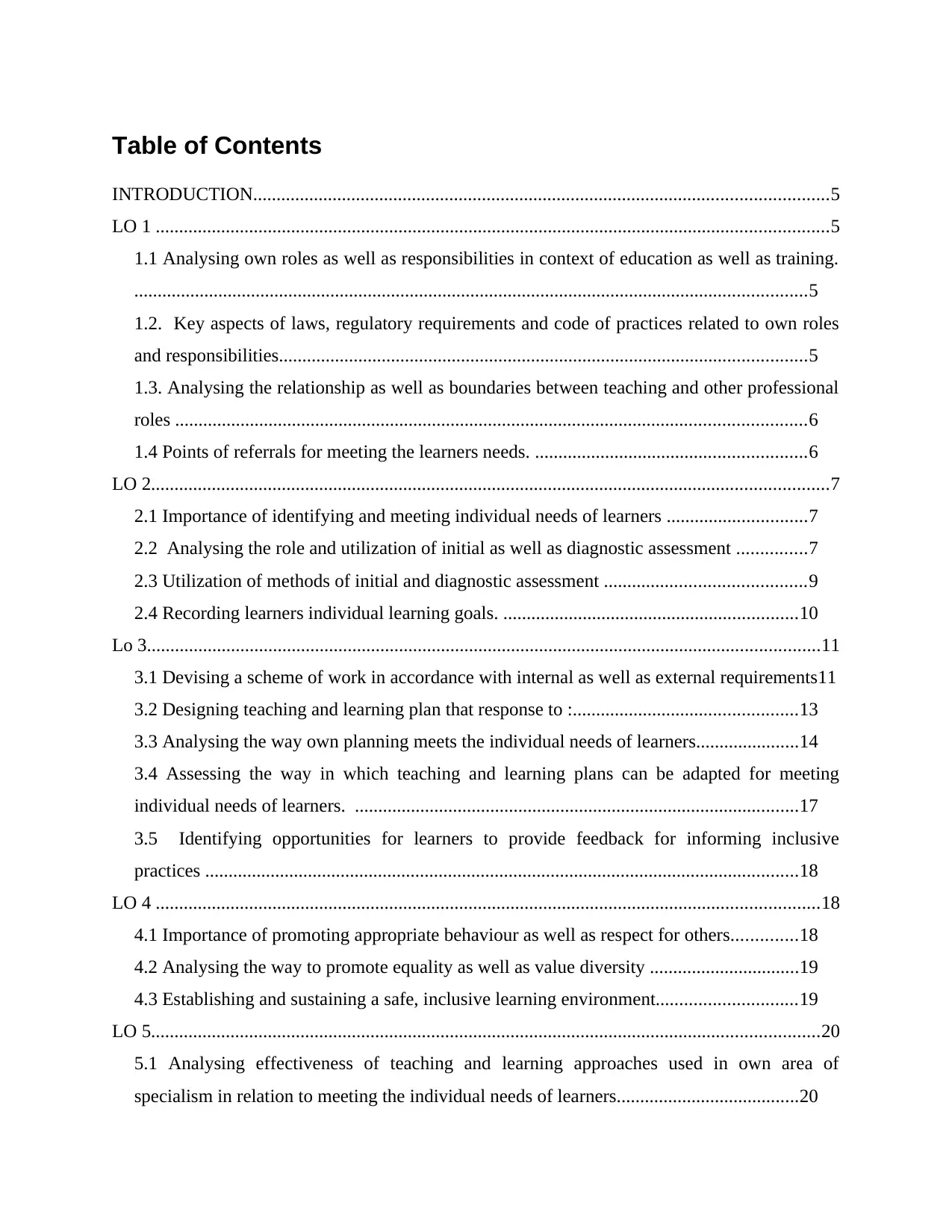
Table of Contents
INTRODUCTION...........................................................................................................................5
LO 1 ................................................................................................................................................5
1.1 Analysing own roles as well as responsibilities in context of education as well as training.
................................................................................................................................................5
1.2. Key aspects of laws, regulatory requirements and code of practices related to own roles
and responsibilities.................................................................................................................5
1.3. Analysing the relationship as well as boundaries between teaching and other professional
roles .......................................................................................................................................6
1.4 Points of referrals for meeting the learners needs. ..........................................................6
LO 2.................................................................................................................................................7
2.1 Importance of identifying and meeting individual needs of learners ..............................7
2.2 Analysing the role and utilization of initial as well as diagnostic assessment ...............7
2.3 Utilization of methods of initial and diagnostic assessment ...........................................9
2.4 Recording learners individual learning goals. ...............................................................10
Lo 3................................................................................................................................................11
3.1 Devising a scheme of work in accordance with internal as well as external requirements11
3.2 Designing teaching and learning plan that response to :................................................13
3.3 Analysing the way own planning meets the individual needs of learners......................14
3.4 Assessing the way in which teaching and learning plans can be adapted for meeting
individual needs of learners. ...............................................................................................17
3.5 Identifying opportunities for learners to provide feedback for informing inclusive
practices ...............................................................................................................................18
LO 4 ..............................................................................................................................................18
4.1 Importance of promoting appropriate behaviour as well as respect for others..............18
4.2 Analysing the way to promote equality as well as value diversity ................................19
4.3 Establishing and sustaining a safe, inclusive learning environment..............................19
LO 5...............................................................................................................................................20
5.1 Analysing effectiveness of teaching and learning approaches used in own area of
specialism in relation to meeting the individual needs of learners.......................................20
INTRODUCTION...........................................................................................................................5
LO 1 ................................................................................................................................................5
1.1 Analysing own roles as well as responsibilities in context of education as well as training.
................................................................................................................................................5
1.2. Key aspects of laws, regulatory requirements and code of practices related to own roles
and responsibilities.................................................................................................................5
1.3. Analysing the relationship as well as boundaries between teaching and other professional
roles .......................................................................................................................................6
1.4 Points of referrals for meeting the learners needs. ..........................................................6
LO 2.................................................................................................................................................7
2.1 Importance of identifying and meeting individual needs of learners ..............................7
2.2 Analysing the role and utilization of initial as well as diagnostic assessment ...............7
2.3 Utilization of methods of initial and diagnostic assessment ...........................................9
2.4 Recording learners individual learning goals. ...............................................................10
Lo 3................................................................................................................................................11
3.1 Devising a scheme of work in accordance with internal as well as external requirements11
3.2 Designing teaching and learning plan that response to :................................................13
3.3 Analysing the way own planning meets the individual needs of learners......................14
3.4 Assessing the way in which teaching and learning plans can be adapted for meeting
individual needs of learners. ...............................................................................................17
3.5 Identifying opportunities for learners to provide feedback for informing inclusive
practices ...............................................................................................................................18
LO 4 ..............................................................................................................................................18
4.1 Importance of promoting appropriate behaviour as well as respect for others..............18
4.2 Analysing the way to promote equality as well as value diversity ................................19
4.3 Establishing and sustaining a safe, inclusive learning environment..............................19
LO 5...............................................................................................................................................20
5.1 Analysing effectiveness of teaching and learning approaches used in own area of
specialism in relation to meeting the individual needs of learners.......................................20
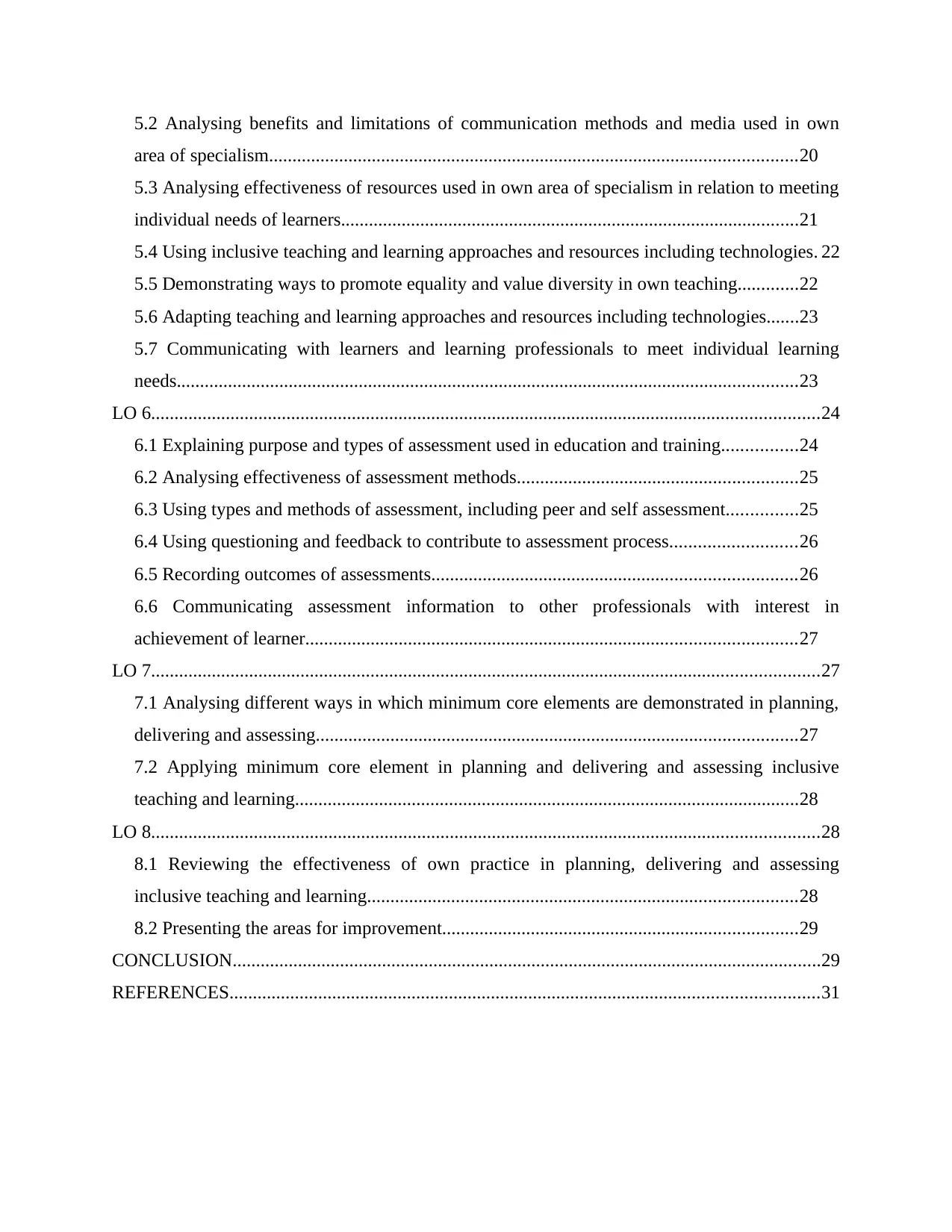
5.2 Analysing benefits and limitations of communication methods and media used in own
area of specialism.................................................................................................................20
5.3 Analysing effectiveness of resources used in own area of specialism in relation to meeting
individual needs of learners..................................................................................................21
5.4 Using inclusive teaching and learning approaches and resources including technologies. 22
5.5 Demonstrating ways to promote equality and value diversity in own teaching.............22
5.6 Adapting teaching and learning approaches and resources including technologies.......23
5.7 Communicating with learners and learning professionals to meet individual learning
needs.....................................................................................................................................23
LO 6...............................................................................................................................................24
6.1 Explaining purpose and types of assessment used in education and training................24
6.2 Analysing effectiveness of assessment methods............................................................25
6.3 Using types and methods of assessment, including peer and self assessment...............25
6.4 Using questioning and feedback to contribute to assessment process...........................26
6.5 Recording outcomes of assessments..............................................................................26
6.6 Communicating assessment information to other professionals with interest in
achievement of learner.........................................................................................................27
LO 7...............................................................................................................................................27
7.1 Analysing different ways in which minimum core elements are demonstrated in planning,
delivering and assessing.......................................................................................................27
7.2 Applying minimum core element in planning and delivering and assessing inclusive
teaching and learning............................................................................................................28
LO 8...............................................................................................................................................28
8.1 Reviewing the effectiveness of own practice in planning, delivering and assessing
inclusive teaching and learning............................................................................................28
8.2 Presenting the areas for improvement............................................................................29
CONCLUSION..............................................................................................................................29
REFERENCES..............................................................................................................................31
area of specialism.................................................................................................................20
5.3 Analysing effectiveness of resources used in own area of specialism in relation to meeting
individual needs of learners..................................................................................................21
5.4 Using inclusive teaching and learning approaches and resources including technologies. 22
5.5 Demonstrating ways to promote equality and value diversity in own teaching.............22
5.6 Adapting teaching and learning approaches and resources including technologies.......23
5.7 Communicating with learners and learning professionals to meet individual learning
needs.....................................................................................................................................23
LO 6...............................................................................................................................................24
6.1 Explaining purpose and types of assessment used in education and training................24
6.2 Analysing effectiveness of assessment methods............................................................25
6.3 Using types and methods of assessment, including peer and self assessment...............25
6.4 Using questioning and feedback to contribute to assessment process...........................26
6.5 Recording outcomes of assessments..............................................................................26
6.6 Communicating assessment information to other professionals with interest in
achievement of learner.........................................................................................................27
LO 7...............................................................................................................................................27
7.1 Analysing different ways in which minimum core elements are demonstrated in planning,
delivering and assessing.......................................................................................................27
7.2 Applying minimum core element in planning and delivering and assessing inclusive
teaching and learning............................................................................................................28
LO 8...............................................................................................................................................28
8.1 Reviewing the effectiveness of own practice in planning, delivering and assessing
inclusive teaching and learning............................................................................................28
8.2 Presenting the areas for improvement............................................................................29
CONCLUSION..............................................................................................................................29
REFERENCES..............................................................................................................................31

Secure Best Marks with AI Grader
Need help grading? Try our AI Grader for instant feedback on your assignments.
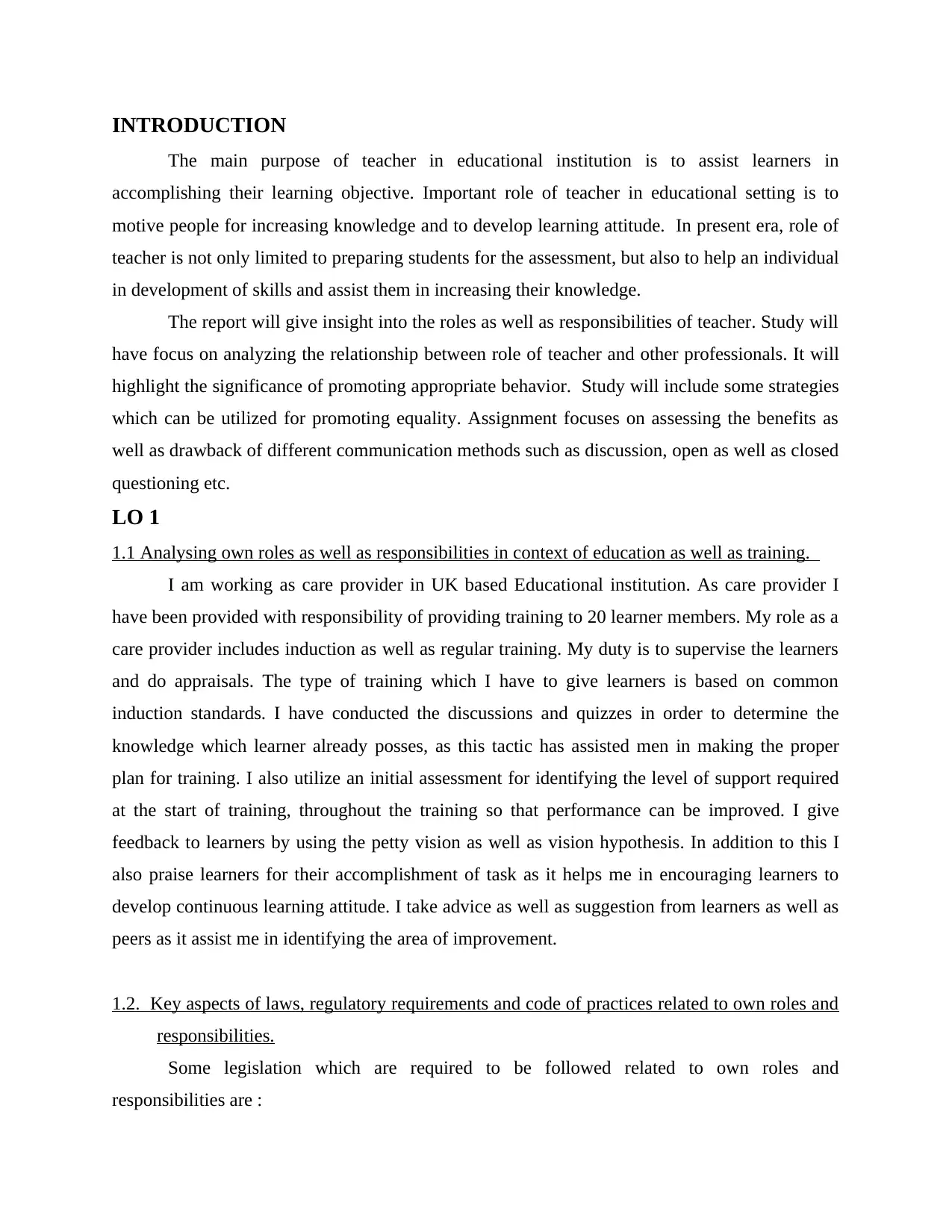
INTRODUCTION
The main purpose of teacher in educational institution is to assist learners in
accomplishing their learning objective. Important role of teacher in educational setting is to
motive people for increasing knowledge and to develop learning attitude. In present era, role of
teacher is not only limited to preparing students for the assessment, but also to help an individual
in development of skills and assist them in increasing their knowledge.
The report will give insight into the roles as well as responsibilities of teacher. Study will
have focus on analyzing the relationship between role of teacher and other professionals. It will
highlight the significance of promoting appropriate behavior. Study will include some strategies
which can be utilized for promoting equality. Assignment focuses on assessing the benefits as
well as drawback of different communication methods such as discussion, open as well as closed
questioning etc.
LO 1
1.1 Analysing own roles as well as responsibilities in context of education as well as training.
I am working as care provider in UK based Educational institution. As care provider I
have been provided with responsibility of providing training to 20 learner members. My role as a
care provider includes induction as well as regular training. My duty is to supervise the learners
and do appraisals. The type of training which I have to give learners is based on common
induction standards. I have conducted the discussions and quizzes in order to determine the
knowledge which learner already posses, as this tactic has assisted men in making the proper
plan for training. I also utilize an initial assessment for identifying the level of support required
at the start of training, throughout the training so that performance can be improved. I give
feedback to learners by using the petty vision as well as vision hypothesis. In addition to this I
also praise learners for their accomplishment of task as it helps me in encouraging learners to
develop continuous learning attitude. I take advice as well as suggestion from learners as well as
peers as it assist me in identifying the area of improvement.
1.2. Key aspects of laws, regulatory requirements and code of practices related to own roles and
responsibilities.
Some legislation which are required to be followed related to own roles and
responsibilities are :
The main purpose of teacher in educational institution is to assist learners in
accomplishing their learning objective. Important role of teacher in educational setting is to
motive people for increasing knowledge and to develop learning attitude. In present era, role of
teacher is not only limited to preparing students for the assessment, but also to help an individual
in development of skills and assist them in increasing their knowledge.
The report will give insight into the roles as well as responsibilities of teacher. Study will
have focus on analyzing the relationship between role of teacher and other professionals. It will
highlight the significance of promoting appropriate behavior. Study will include some strategies
which can be utilized for promoting equality. Assignment focuses on assessing the benefits as
well as drawback of different communication methods such as discussion, open as well as closed
questioning etc.
LO 1
1.1 Analysing own roles as well as responsibilities in context of education as well as training.
I am working as care provider in UK based Educational institution. As care provider I
have been provided with responsibility of providing training to 20 learner members. My role as a
care provider includes induction as well as regular training. My duty is to supervise the learners
and do appraisals. The type of training which I have to give learners is based on common
induction standards. I have conducted the discussions and quizzes in order to determine the
knowledge which learner already posses, as this tactic has assisted men in making the proper
plan for training. I also utilize an initial assessment for identifying the level of support required
at the start of training, throughout the training so that performance can be improved. I give
feedback to learners by using the petty vision as well as vision hypothesis. In addition to this I
also praise learners for their accomplishment of task as it helps me in encouraging learners to
develop continuous learning attitude. I take advice as well as suggestion from learners as well as
peers as it assist me in identifying the area of improvement.
1.2. Key aspects of laws, regulatory requirements and code of practices related to own roles and
responsibilities.
Some legislation which are required to be followed related to own roles and
responsibilities are :
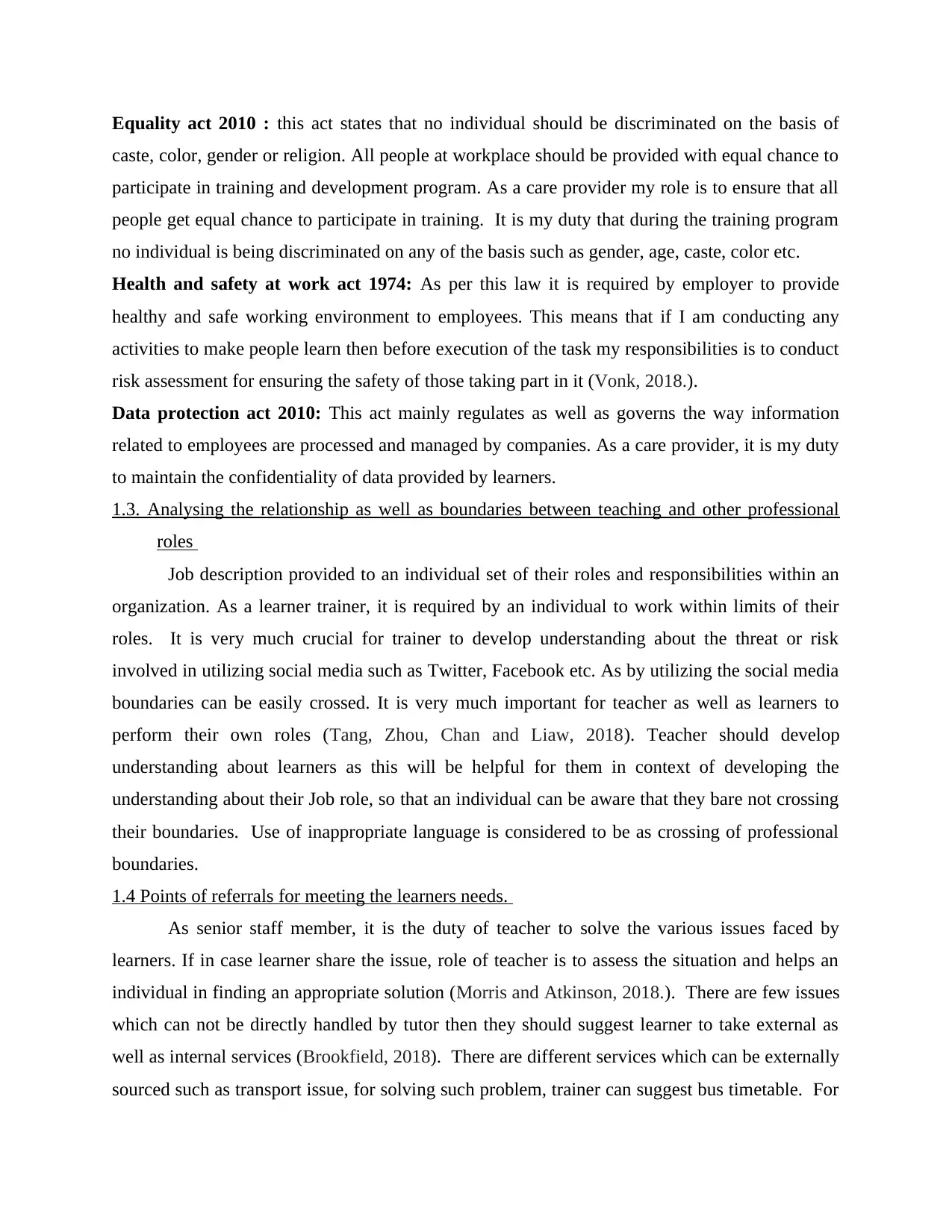
Equality act 2010 : this act states that no individual should be discriminated on the basis of
caste, color, gender or religion. All people at workplace should be provided with equal chance to
participate in training and development program. As a care provider my role is to ensure that all
people get equal chance to participate in training. It is my duty that during the training program
no individual is being discriminated on any of the basis such as gender, age, caste, color etc.
Health and safety at work act 1974: As per this law it is required by employer to provide
healthy and safe working environment to employees. This means that if I am conducting any
activities to make people learn then before execution of the task my responsibilities is to conduct
risk assessment for ensuring the safety of those taking part in it (Vonk, 2018.).
Data protection act 2010: This act mainly regulates as well as governs the way information
related to employees are processed and managed by companies. As a care provider, it is my duty
to maintain the confidentiality of data provided by learners.
1.3. Analysing the relationship as well as boundaries between teaching and other professional
roles
Job description provided to an individual set of their roles and responsibilities within an
organization. As a learner trainer, it is required by an individual to work within limits of their
roles. It is very much crucial for trainer to develop understanding about the threat or risk
involved in utilizing social media such as Twitter, Facebook etc. As by utilizing the social media
boundaries can be easily crossed. It is very much important for teacher as well as learners to
perform their own roles (Tang, Zhou, Chan and Liaw, 2018). Teacher should develop
understanding about learners as this will be helpful for them in context of developing the
understanding about their Job role, so that an individual can be aware that they bare not crossing
their boundaries. Use of inappropriate language is considered to be as crossing of professional
boundaries.
1.4 Points of referrals for meeting the learners needs.
As senior staff member, it is the duty of teacher to solve the various issues faced by
learners. If in case learner share the issue, role of teacher is to assess the situation and helps an
individual in finding an appropriate solution (Morris and Atkinson, 2018.). There are few issues
which can not be directly handled by tutor then they should suggest learner to take external as
well as internal services (Brookfield, 2018). There are different services which can be externally
sourced such as transport issue, for solving such problem, trainer can suggest bus timetable. For
caste, color, gender or religion. All people at workplace should be provided with equal chance to
participate in training and development program. As a care provider my role is to ensure that all
people get equal chance to participate in training. It is my duty that during the training program
no individual is being discriminated on any of the basis such as gender, age, caste, color etc.
Health and safety at work act 1974: As per this law it is required by employer to provide
healthy and safe working environment to employees. This means that if I am conducting any
activities to make people learn then before execution of the task my responsibilities is to conduct
risk assessment for ensuring the safety of those taking part in it (Vonk, 2018.).
Data protection act 2010: This act mainly regulates as well as governs the way information
related to employees are processed and managed by companies. As a care provider, it is my duty
to maintain the confidentiality of data provided by learners.
1.3. Analysing the relationship as well as boundaries between teaching and other professional
roles
Job description provided to an individual set of their roles and responsibilities within an
organization. As a learner trainer, it is required by an individual to work within limits of their
roles. It is very much crucial for trainer to develop understanding about the threat or risk
involved in utilizing social media such as Twitter, Facebook etc. As by utilizing the social media
boundaries can be easily crossed. It is very much important for teacher as well as learners to
perform their own roles (Tang, Zhou, Chan and Liaw, 2018). Teacher should develop
understanding about learners as this will be helpful for them in context of developing the
understanding about their Job role, so that an individual can be aware that they bare not crossing
their boundaries. Use of inappropriate language is considered to be as crossing of professional
boundaries.
1.4 Points of referrals for meeting the learners needs.
As senior staff member, it is the duty of teacher to solve the various issues faced by
learners. If in case learner share the issue, role of teacher is to assess the situation and helps an
individual in finding an appropriate solution (Morris and Atkinson, 2018.). There are few issues
which can not be directly handled by tutor then they should suggest learner to take external as
well as internal services (Brookfield, 2018). There are different services which can be externally
sourced such as transport issue, for solving such problem, trainer can suggest bus timetable. For
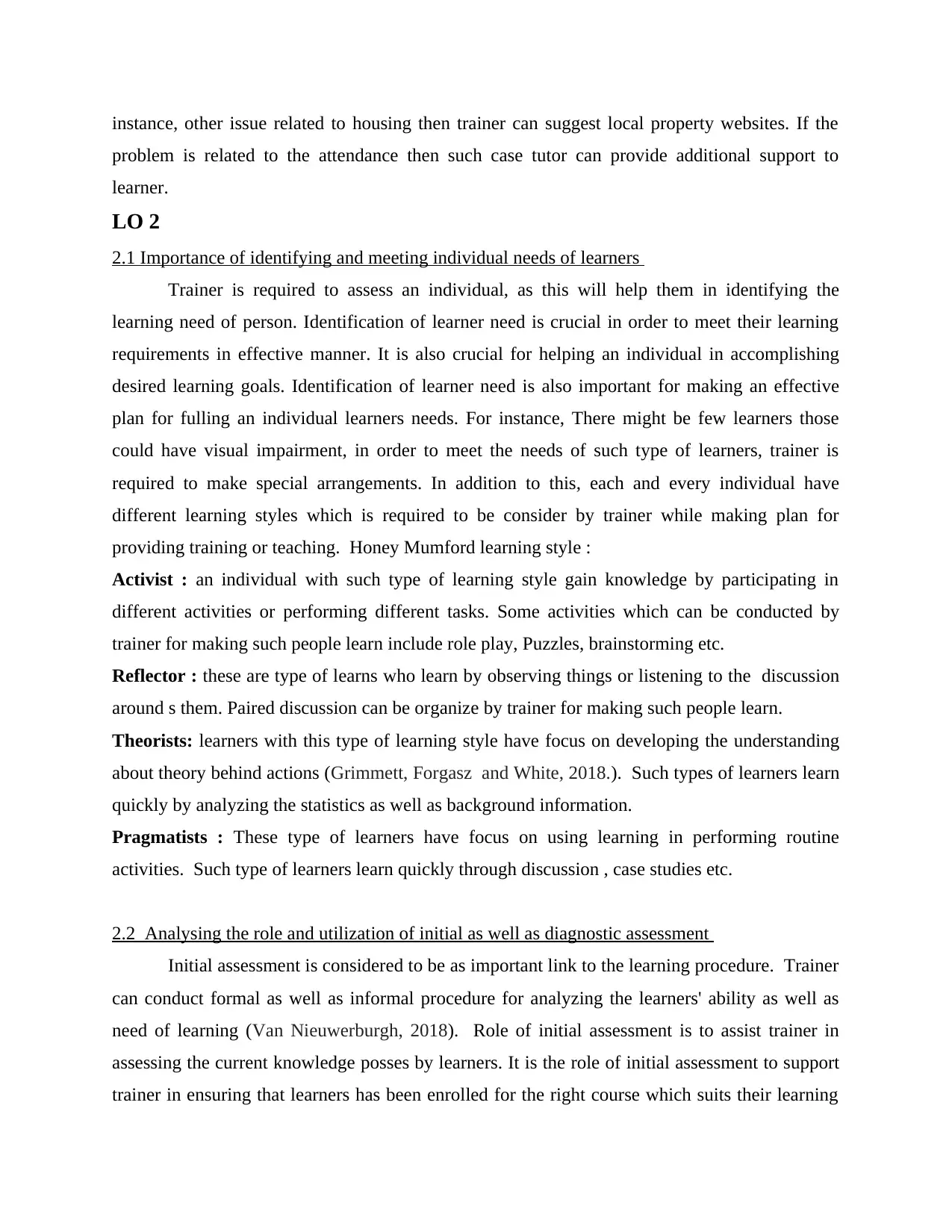
instance, other issue related to housing then trainer can suggest local property websites. If the
problem is related to the attendance then such case tutor can provide additional support to
learner.
LO 2
2.1 Importance of identifying and meeting individual needs of learners
Trainer is required to assess an individual, as this will help them in identifying the
learning need of person. Identification of learner need is crucial in order to meet their learning
requirements in effective manner. It is also crucial for helping an individual in accomplishing
desired learning goals. Identification of learner need is also important for making an effective
plan for fulling an individual learners needs. For instance, There might be few learners those
could have visual impairment, in order to meet the needs of such type of learners, trainer is
required to make special arrangements. In addition to this, each and every individual have
different learning styles which is required to be consider by trainer while making plan for
providing training or teaching. Honey Mumford learning style :
Activist : an individual with such type of learning style gain knowledge by participating in
different activities or performing different tasks. Some activities which can be conducted by
trainer for making such people learn include role play, Puzzles, brainstorming etc.
Reflector : these are type of learns who learn by observing things or listening to the discussion
around s them. Paired discussion can be organize by trainer for making such people learn.
Theorists: learners with this type of learning style have focus on developing the understanding
about theory behind actions (Grimmett, Forgasz and White, 2018.). Such types of learners learn
quickly by analyzing the statistics as well as background information.
Pragmatists : These type of learners have focus on using learning in performing routine
activities. Such type of learners learn quickly through discussion , case studies etc.
2.2 Analysing the role and utilization of initial as well as diagnostic assessment
Initial assessment is considered to be as important link to the learning procedure. Trainer
can conduct formal as well as informal procedure for analyzing the learners' ability as well as
need of learning (Van Nieuwerburgh, 2018). Role of initial assessment is to assist trainer in
assessing the current knowledge posses by learners. It is the role of initial assessment to support
trainer in ensuring that learners has been enrolled for the right course which suits their learning
problem is related to the attendance then such case tutor can provide additional support to
learner.
LO 2
2.1 Importance of identifying and meeting individual needs of learners
Trainer is required to assess an individual, as this will help them in identifying the
learning need of person. Identification of learner need is crucial in order to meet their learning
requirements in effective manner. It is also crucial for helping an individual in accomplishing
desired learning goals. Identification of learner need is also important for making an effective
plan for fulling an individual learners needs. For instance, There might be few learners those
could have visual impairment, in order to meet the needs of such type of learners, trainer is
required to make special arrangements. In addition to this, each and every individual have
different learning styles which is required to be consider by trainer while making plan for
providing training or teaching. Honey Mumford learning style :
Activist : an individual with such type of learning style gain knowledge by participating in
different activities or performing different tasks. Some activities which can be conducted by
trainer for making such people learn include role play, Puzzles, brainstorming etc.
Reflector : these are type of learns who learn by observing things or listening to the discussion
around s them. Paired discussion can be organize by trainer for making such people learn.
Theorists: learners with this type of learning style have focus on developing the understanding
about theory behind actions (Grimmett, Forgasz and White, 2018.). Such types of learners learn
quickly by analyzing the statistics as well as background information.
Pragmatists : These type of learners have focus on using learning in performing routine
activities. Such type of learners learn quickly through discussion , case studies etc.
2.2 Analysing the role and utilization of initial as well as diagnostic assessment
Initial assessment is considered to be as important link to the learning procedure. Trainer
can conduct formal as well as informal procedure for analyzing the learners' ability as well as
need of learning (Van Nieuwerburgh, 2018). Role of initial assessment is to assist trainer in
assessing the current knowledge posses by learners. It is the role of initial assessment to support
trainer in ensuring that learners has been enrolled for the right course which suits their learning
Paraphrase This Document
Need a fresh take? Get an instant paraphrase of this document with our AI Paraphraser
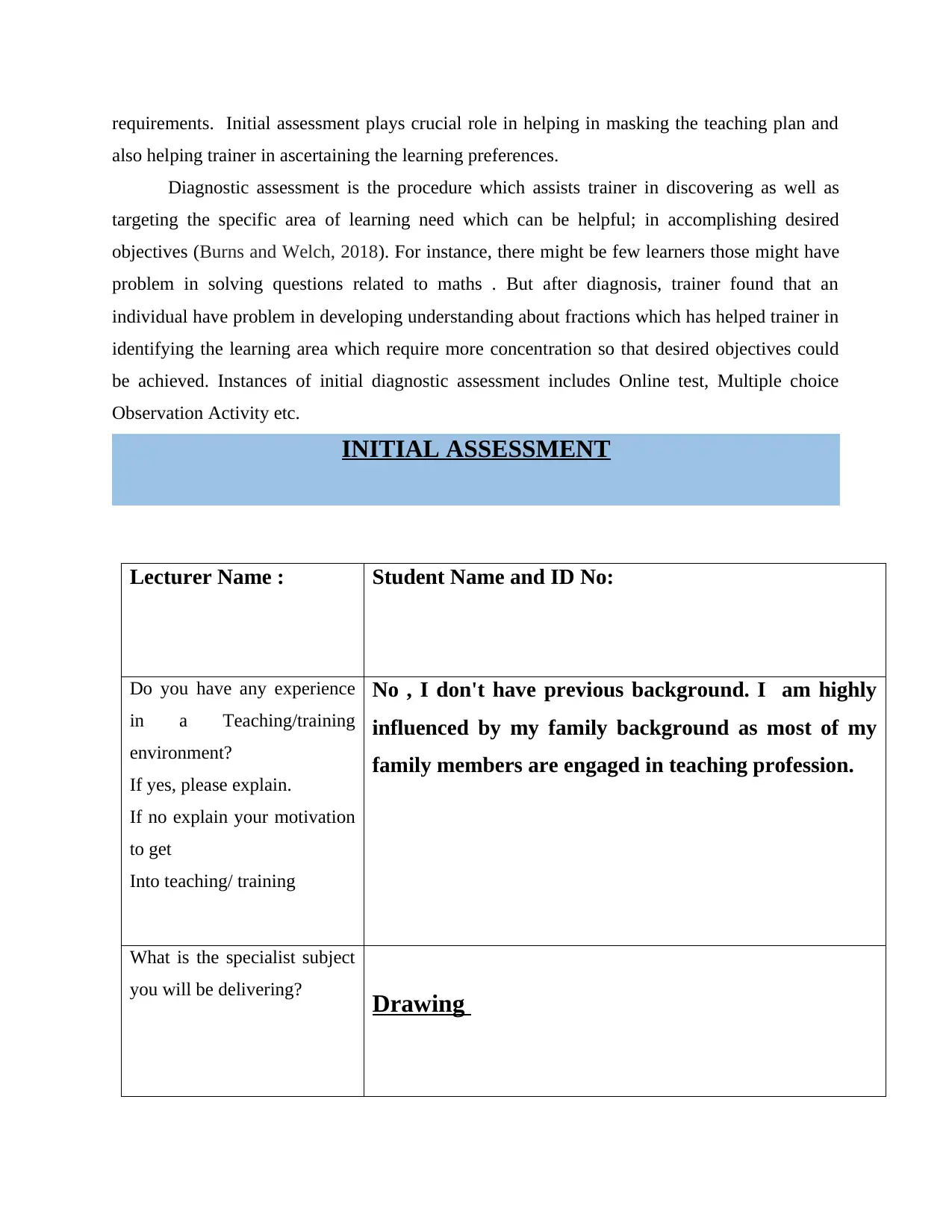
requirements. Initial assessment plays crucial role in helping in masking the teaching plan and
also helping trainer in ascertaining the learning preferences.
Diagnostic assessment is the procedure which assists trainer in discovering as well as
targeting the specific area of learning need which can be helpful; in accomplishing desired
objectives (Burns and Welch, 2018). For instance, there might be few learners those might have
problem in solving questions related to maths . But after diagnosis, trainer found that an
individual have problem in developing understanding about fractions which has helped trainer in
identifying the learning area which require more concentration so that desired objectives could
be achieved. Instances of initial diagnostic assessment includes Online test, Multiple choice
Observation Activity etc.
INITIAL ASSESSMENT
Lecturer Name : Student Name and ID No:
Do you have any experience
in a Teaching/training
environment?
If yes, please explain.
If no explain your motivation
to get
Into teaching/ training
No , I don't have previous background. I am highly
influenced by my family background as most of my
family members are engaged in teaching profession.
What is the specialist subject
you will be delivering? Drawing
also helping trainer in ascertaining the learning preferences.
Diagnostic assessment is the procedure which assists trainer in discovering as well as
targeting the specific area of learning need which can be helpful; in accomplishing desired
objectives (Burns and Welch, 2018). For instance, there might be few learners those might have
problem in solving questions related to maths . But after diagnosis, trainer found that an
individual have problem in developing understanding about fractions which has helped trainer in
identifying the learning area which require more concentration so that desired objectives could
be achieved. Instances of initial diagnostic assessment includes Online test, Multiple choice
Observation Activity etc.
INITIAL ASSESSMENT
Lecturer Name : Student Name and ID No:
Do you have any experience
in a Teaching/training
environment?
If yes, please explain.
If no explain your motivation
to get
Into teaching/ training
No , I don't have previous background. I am highly
influenced by my family background as most of my
family members are engaged in teaching profession.
What is the specialist subject
you will be delivering? Drawing
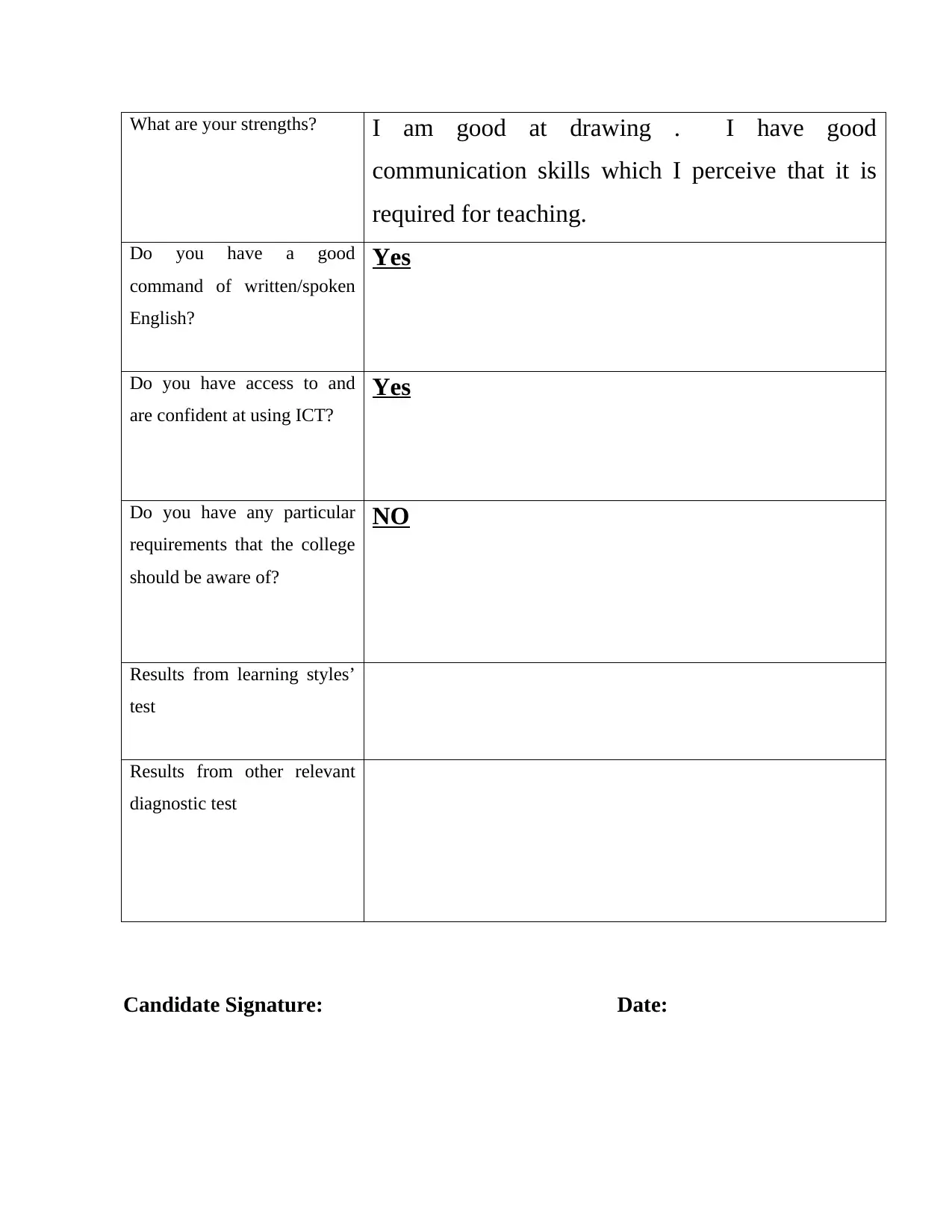
What are your strengths? I am good at drawing . I have good
communication skills which I perceive that it is
required for teaching.
Do you have a good
command of written/spoken
English?
Yes
Do you have access to and
are confident at using ICT?
Yes
Do you have any particular
requirements that the college
should be aware of?
NO
Results from learning styles’
test
Results from other relevant
diagnostic test
Candidate Signature: Date:
communication skills which I perceive that it is
required for teaching.
Do you have a good
command of written/spoken
English?
Yes
Do you have access to and
are confident at using ICT?
Yes
Do you have any particular
requirements that the college
should be aware of?
NO
Results from learning styles’
test
Results from other relevant
diagnostic test
Candidate Signature: Date:
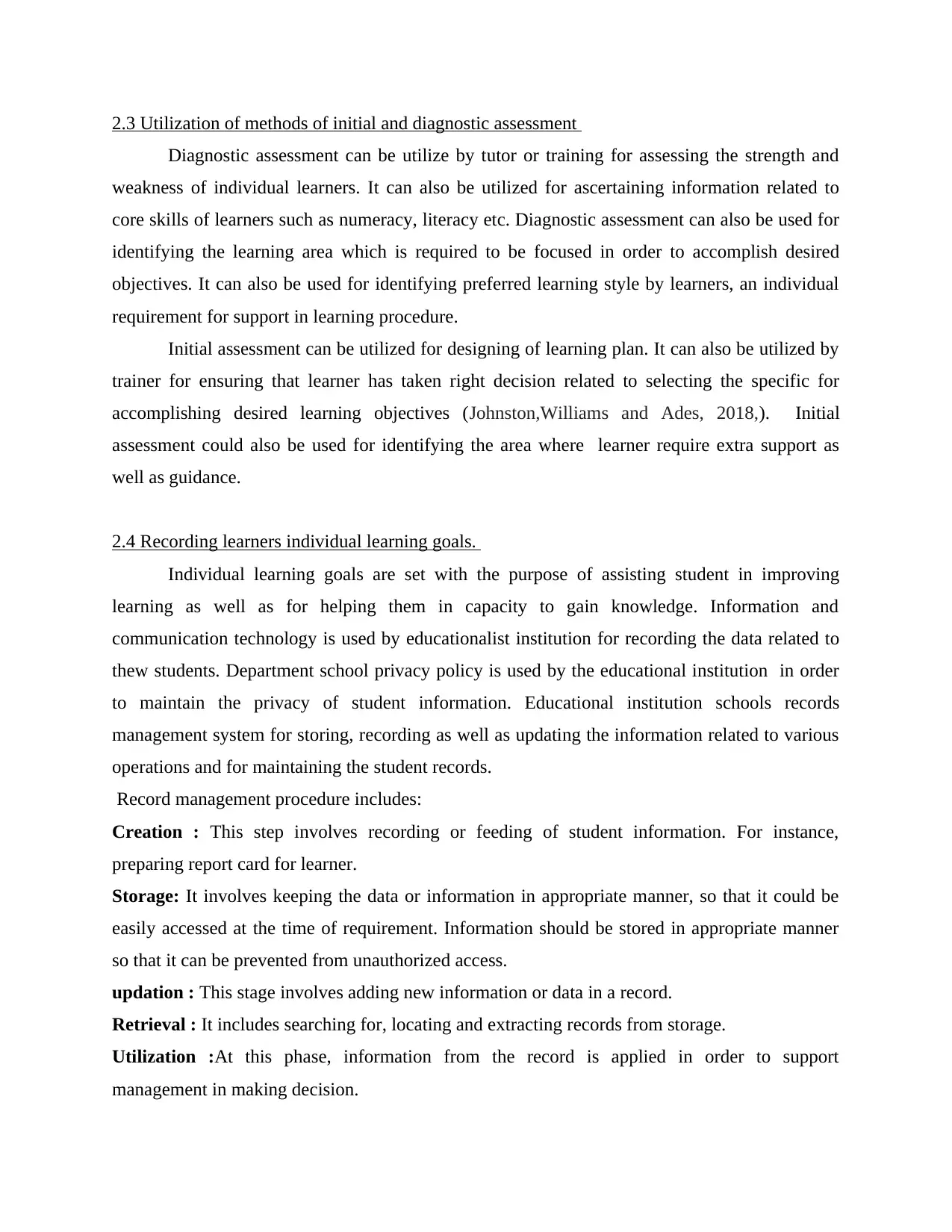
2.3 Utilization of methods of initial and diagnostic assessment
Diagnostic assessment can be utilize by tutor or training for assessing the strength and
weakness of individual learners. It can also be utilized for ascertaining information related to
core skills of learners such as numeracy, literacy etc. Diagnostic assessment can also be used for
identifying the learning area which is required to be focused in order to accomplish desired
objectives. It can also be used for identifying preferred learning style by learners, an individual
requirement for support in learning procedure.
Initial assessment can be utilized for designing of learning plan. It can also be utilized by
trainer for ensuring that learner has taken right decision related to selecting the specific for
accomplishing desired learning objectives (Johnston,Williams and Ades, 2018,). Initial
assessment could also be used for identifying the area where learner require extra support as
well as guidance.
2.4 Recording learners individual learning goals.
Individual learning goals are set with the purpose of assisting student in improving
learning as well as for helping them in capacity to gain knowledge. Information and
communication technology is used by educationalist institution for recording the data related to
thew students. Department school privacy policy is used by the educational institution in order
to maintain the privacy of student information. Educational institution schools records
management system for storing, recording as well as updating the information related to various
operations and for maintaining the student records.
Record management procedure includes:
Creation : This step involves recording or feeding of student information. For instance,
preparing report card for learner.
Storage: It involves keeping the data or information in appropriate manner, so that it could be
easily accessed at the time of requirement. Information should be stored in appropriate manner
so that it can be prevented from unauthorized access.
updation : This stage involves adding new information or data in a record.
Retrieval : It includes searching for, locating and extracting records from storage.
Utilization :At this phase, information from the record is applied in order to support
management in making decision.
Diagnostic assessment can be utilize by tutor or training for assessing the strength and
weakness of individual learners. It can also be utilized for ascertaining information related to
core skills of learners such as numeracy, literacy etc. Diagnostic assessment can also be used for
identifying the learning area which is required to be focused in order to accomplish desired
objectives. It can also be used for identifying preferred learning style by learners, an individual
requirement for support in learning procedure.
Initial assessment can be utilized for designing of learning plan. It can also be utilized by
trainer for ensuring that learner has taken right decision related to selecting the specific for
accomplishing desired learning objectives (Johnston,Williams and Ades, 2018,). Initial
assessment could also be used for identifying the area where learner require extra support as
well as guidance.
2.4 Recording learners individual learning goals.
Individual learning goals are set with the purpose of assisting student in improving
learning as well as for helping them in capacity to gain knowledge. Information and
communication technology is used by educationalist institution for recording the data related to
thew students. Department school privacy policy is used by the educational institution in order
to maintain the privacy of student information. Educational institution schools records
management system for storing, recording as well as updating the information related to various
operations and for maintaining the student records.
Record management procedure includes:
Creation : This step involves recording or feeding of student information. For instance,
preparing report card for learner.
Storage: It involves keeping the data or information in appropriate manner, so that it could be
easily accessed at the time of requirement. Information should be stored in appropriate manner
so that it can be prevented from unauthorized access.
updation : This stage involves adding new information or data in a record.
Retrieval : It includes searching for, locating and extracting records from storage.
Utilization :At this phase, information from the record is applied in order to support
management in making decision.
Secure Best Marks with AI Grader
Need help grading? Try our AI Grader for instant feedback on your assignments.
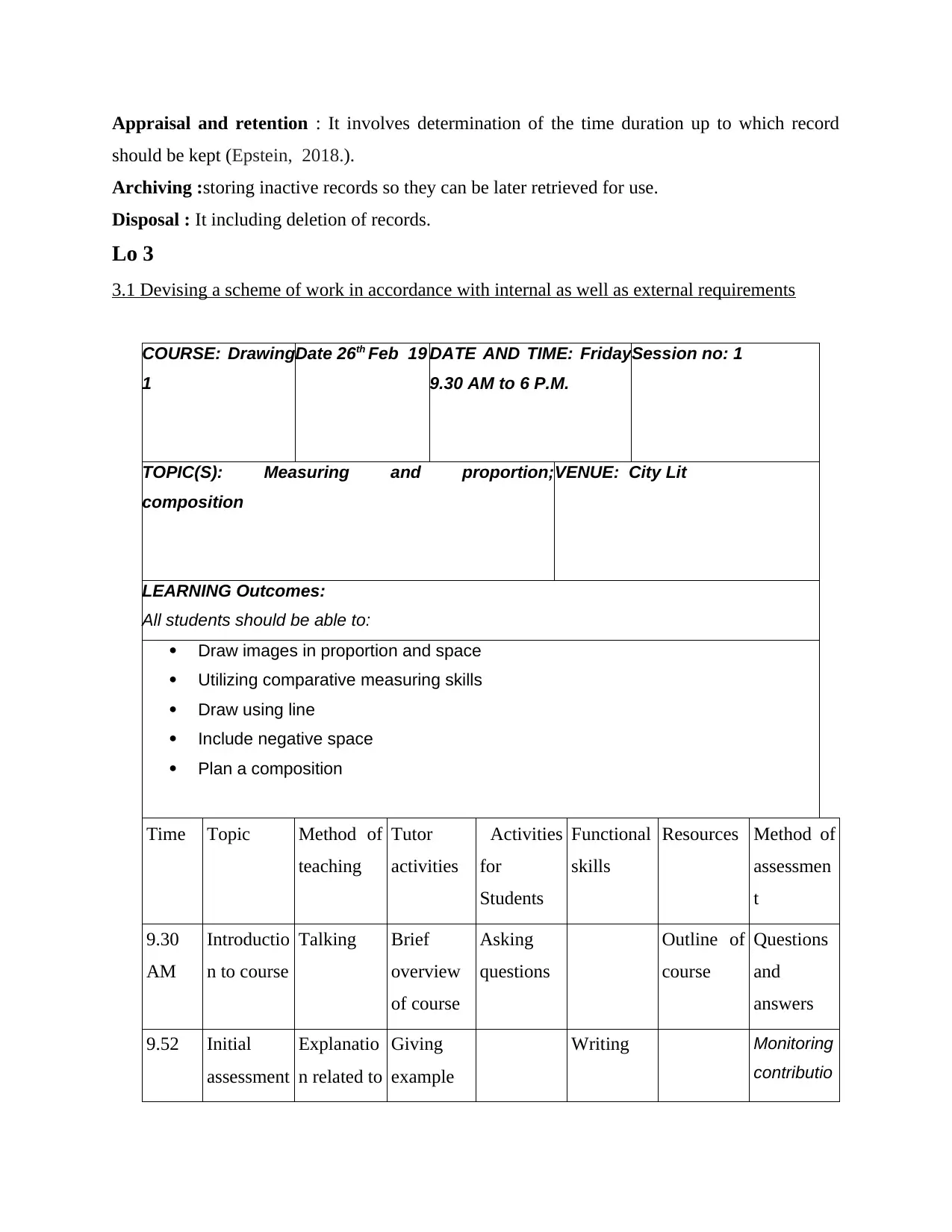
Appraisal and retention : It involves determination of the time duration up to which record
should be kept (Epstein, 2018.).
Archiving :storing inactive records so they can be later retrieved for use.
Disposal : It including deletion of records.
Lo 3
3.1 Devising a scheme of work in accordance with internal as well as external requirements
COURSE: Drawing
1
Date 26th Feb 19 DATE AND TIME: Friday
9.30 AM to 6 P.M.
Session no: 1
TOPIC(S): Measuring and proportion;
composition
VENUE: City Lit
LEARNING Outcomes:
All students should be able to:
Draw images in proportion and space
Utilizing comparative measuring skills
Draw using line
Include negative space
Plan a composition
Time Topic Method of
teaching
Tutor
activities
Activities
for
Students
Functional
skills
Resources Method of
assessmen
t
9.30
AM
Introductio
n to course
Talking Brief
overview
of course
Asking
questions
Outline of
course
Questions
and
answers
9.52 Initial
assessment
Explanatio
n related to
Giving
example
Writing Monitoring
contributio
should be kept (Epstein, 2018.).
Archiving :storing inactive records so they can be later retrieved for use.
Disposal : It including deletion of records.
Lo 3
3.1 Devising a scheme of work in accordance with internal as well as external requirements
COURSE: Drawing
1
Date 26th Feb 19 DATE AND TIME: Friday
9.30 AM to 6 P.M.
Session no: 1
TOPIC(S): Measuring and proportion;
composition
VENUE: City Lit
LEARNING Outcomes:
All students should be able to:
Draw images in proportion and space
Utilizing comparative measuring skills
Draw using line
Include negative space
Plan a composition
Time Topic Method of
teaching
Tutor
activities
Activities
for
Students
Functional
skills
Resources Method of
assessmen
t
9.30
AM
Introductio
n to course
Talking Brief
overview
of course
Asking
questions
Outline of
course
Questions
and
answers
9.52 Initial
assessment
Explanatio
n related to
Giving
example
Writing Monitoring
contributio
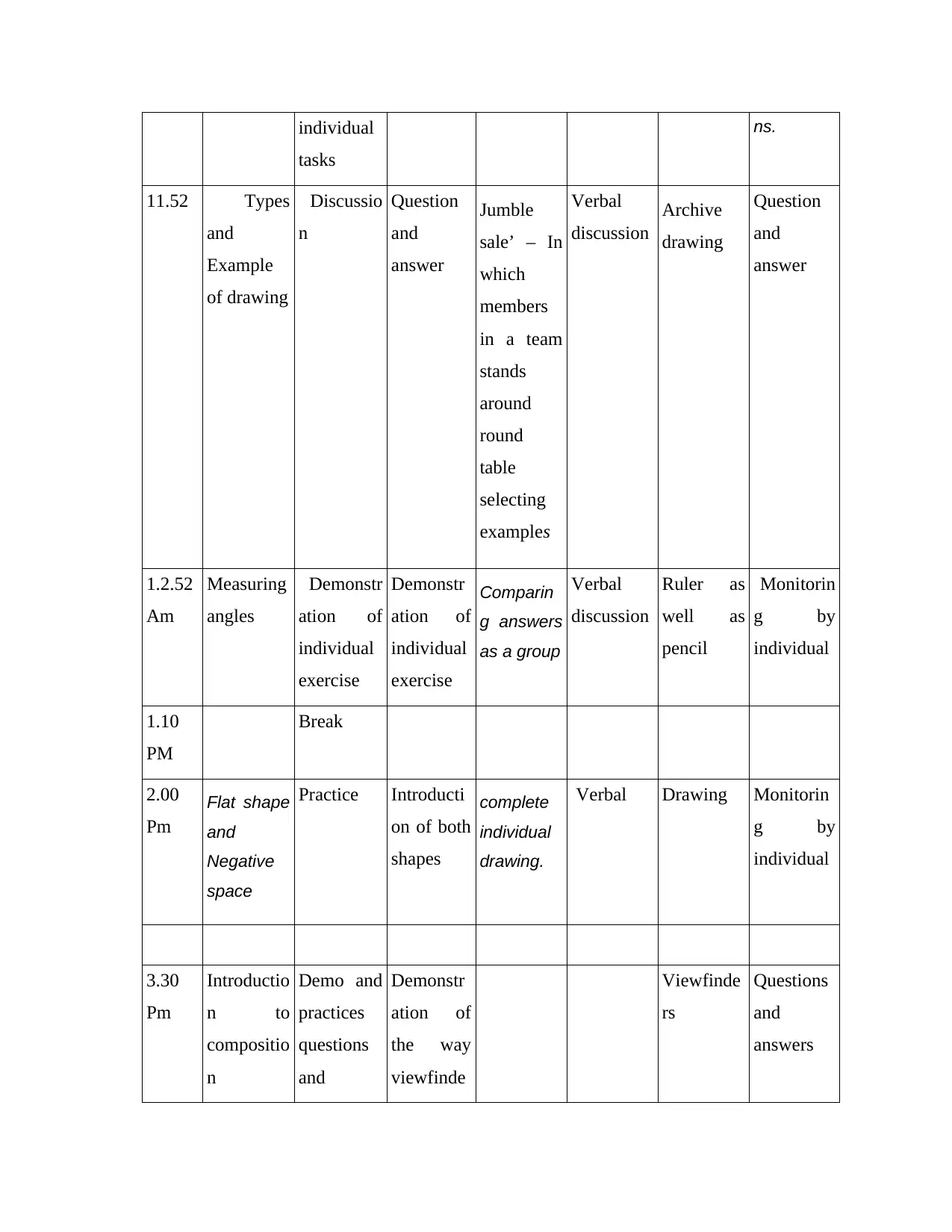
individual
tasks
ns.
11.52 Types
and
Example
of drawing
Discussio
n
Question
and
answer
Jumble
sale’ – In
which
members
in a team
stands
around
round
table
selecting
examples
Verbal
discussion
Archive
drawing
Question
and
answer
1.2.52
Am
Measuring
angles
Demonstr
ation of
individual
exercise
Demonstr
ation of
individual
exercise
Comparin
g answers
as a group
Verbal
discussion
Ruler as
well as
pencil
Monitorin
g by
individual
1.10
PM
Break
2.00
Pm
Flat shape
and
Negative
space
Practice Introducti
on of both
shapes
complete
individual
drawing.
Verbal Drawing Monitorin
g by
individual
3.30
Pm
Introductio
n to
compositio
n
Demo and
practices
questions
and
Demonstr
ation of
the way
viewfinde
Viewfinde
rs
Questions
and
answers
tasks
ns.
11.52 Types
and
Example
of drawing
Discussio
n
Question
and
answer
Jumble
sale’ – In
which
members
in a team
stands
around
round
table
selecting
examples
Verbal
discussion
Archive
drawing
Question
and
answer
1.2.52
Am
Measuring
angles
Demonstr
ation of
individual
exercise
Demonstr
ation of
individual
exercise
Comparin
g answers
as a group
Verbal
discussion
Ruler as
well as
pencil
Monitorin
g by
individual
1.10
PM
Break
2.00
Pm
Flat shape
and
Negative
space
Practice Introducti
on of both
shapes
complete
individual
drawing.
Verbal Drawing Monitorin
g by
individual
3.30
Pm
Introductio
n to
compositio
n
Demo and
practices
questions
and
Demonstr
ation of
the way
viewfinde
Viewfinde
rs
Questions
and
answers
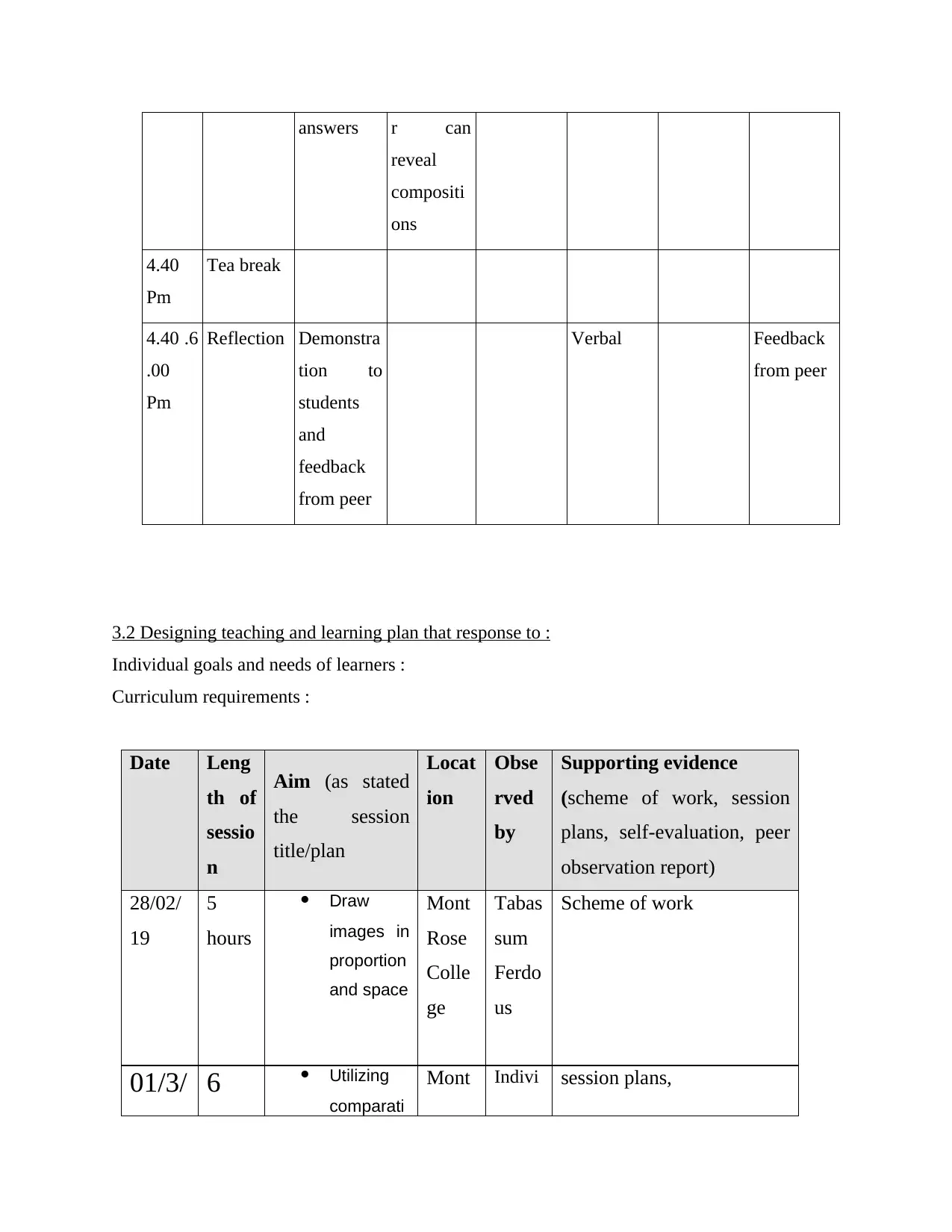
answers r can
reveal
compositi
ons
4.40
Pm
Tea break
4.40 .6
.00
Pm
Reflection Demonstra
tion to
students
and
feedback
from peer
Verbal Feedback
from peer
3.2 Designing teaching and learning plan that response to :
Individual goals and needs of learners :
Curriculum requirements :
Date Leng
th of
sessio
n
Aim (as stated
the session
title/plan
Locat
ion
Obse
rved
by
Supporting evidence
(scheme of work, session
plans, self-evaluation, peer
observation report)
28/02/
19
5
hours
Draw
images in
proportion
and space
Mont
Rose
Colle
ge
Tabas
sum
Ferdo
us
Scheme of work
01/3/ 6 Utilizing
comparati
Mont Indivi session plans,
reveal
compositi
ons
4.40
Pm
Tea break
4.40 .6
.00
Pm
Reflection Demonstra
tion to
students
and
feedback
from peer
Verbal Feedback
from peer
3.2 Designing teaching and learning plan that response to :
Individual goals and needs of learners :
Curriculum requirements :
Date Leng
th of
sessio
n
Aim (as stated
the session
title/plan
Locat
ion
Obse
rved
by
Supporting evidence
(scheme of work, session
plans, self-evaluation, peer
observation report)
28/02/
19
5
hours
Draw
images in
proportion
and space
Mont
Rose
Colle
ge
Tabas
sum
Ferdo
us
Scheme of work
01/3/ 6 Utilizing
comparati
Mont Indivi session plans,
Paraphrase This Document
Need a fresh take? Get an instant paraphrase of this document with our AI Paraphraser
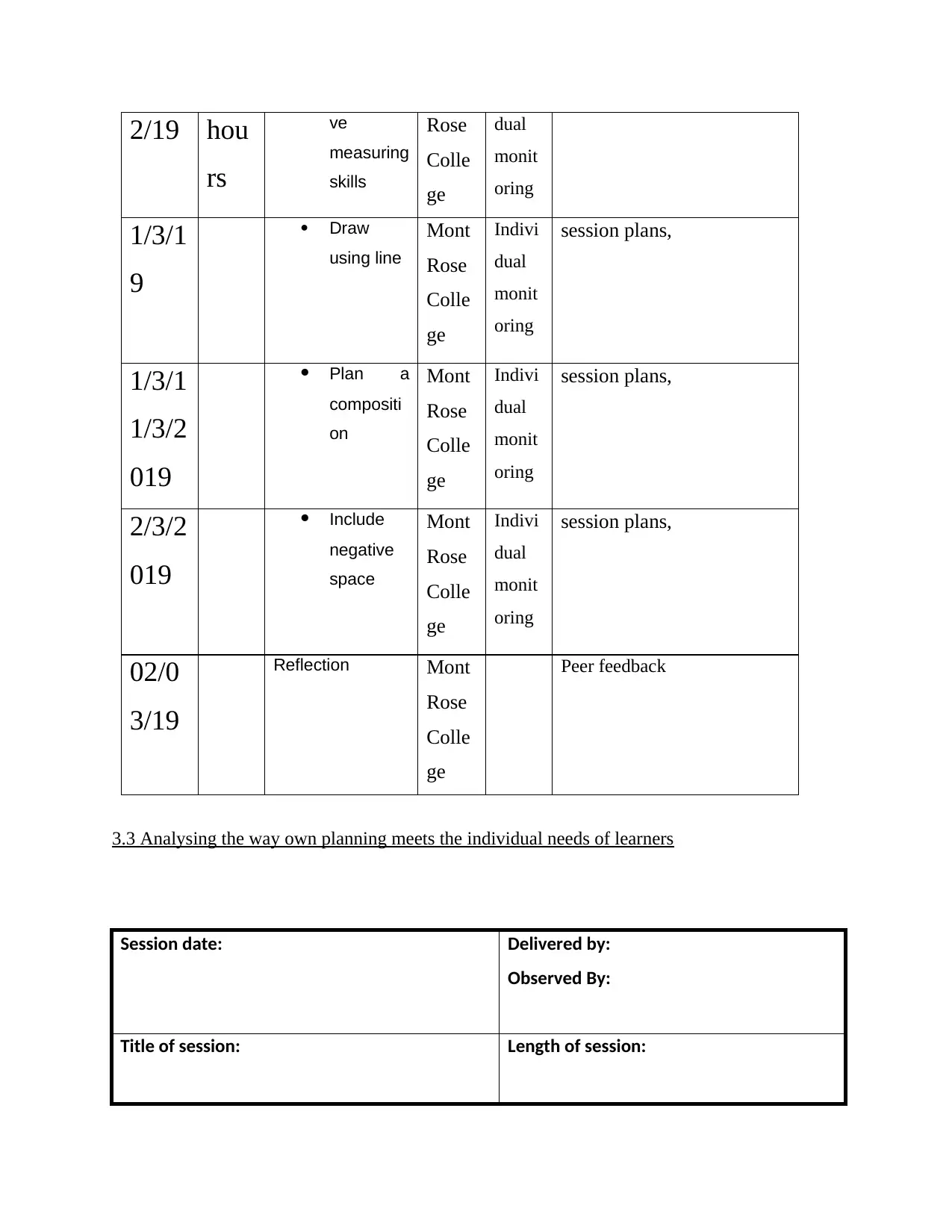
2/19 hou
rs
ve
measuring
skills
Rose
Colle
ge
dual
monit
oring
1/3/1
9
Draw
using line
Mont
Rose
Colle
ge
Indivi
dual
monit
oring
session plans,
1/3/1
1/3/2
019
Plan a
compositi
on
Mont
Rose
Colle
ge
Indivi
dual
monit
oring
session plans,
2/3/2
019
Include
negative
space
Mont
Rose
Colle
ge
Indivi
dual
monit
oring
session plans,
02/0
3/19
Reflection Mont
Rose
Colle
ge
Peer feedback
3.3 Analysing the way own planning meets the individual needs of learners
Session date: Delivered by:
Observed By:
Title of session: Length of session:
rs
ve
measuring
skills
Rose
Colle
ge
dual
monit
oring
1/3/1
9
Draw
using line
Mont
Rose
Colle
ge
Indivi
dual
monit
oring
session plans,
1/3/1
1/3/2
019
Plan a
compositi
on
Mont
Rose
Colle
ge
Indivi
dual
monit
oring
session plans,
2/3/2
019
Include
negative
space
Mont
Rose
Colle
ge
Indivi
dual
monit
oring
session plans,
02/0
3/19
Reflection Mont
Rose
Colle
ge
Peer feedback
3.3 Analysing the way own planning meets the individual needs of learners
Session date: Delivered by:
Observed By:
Title of session: Length of session:
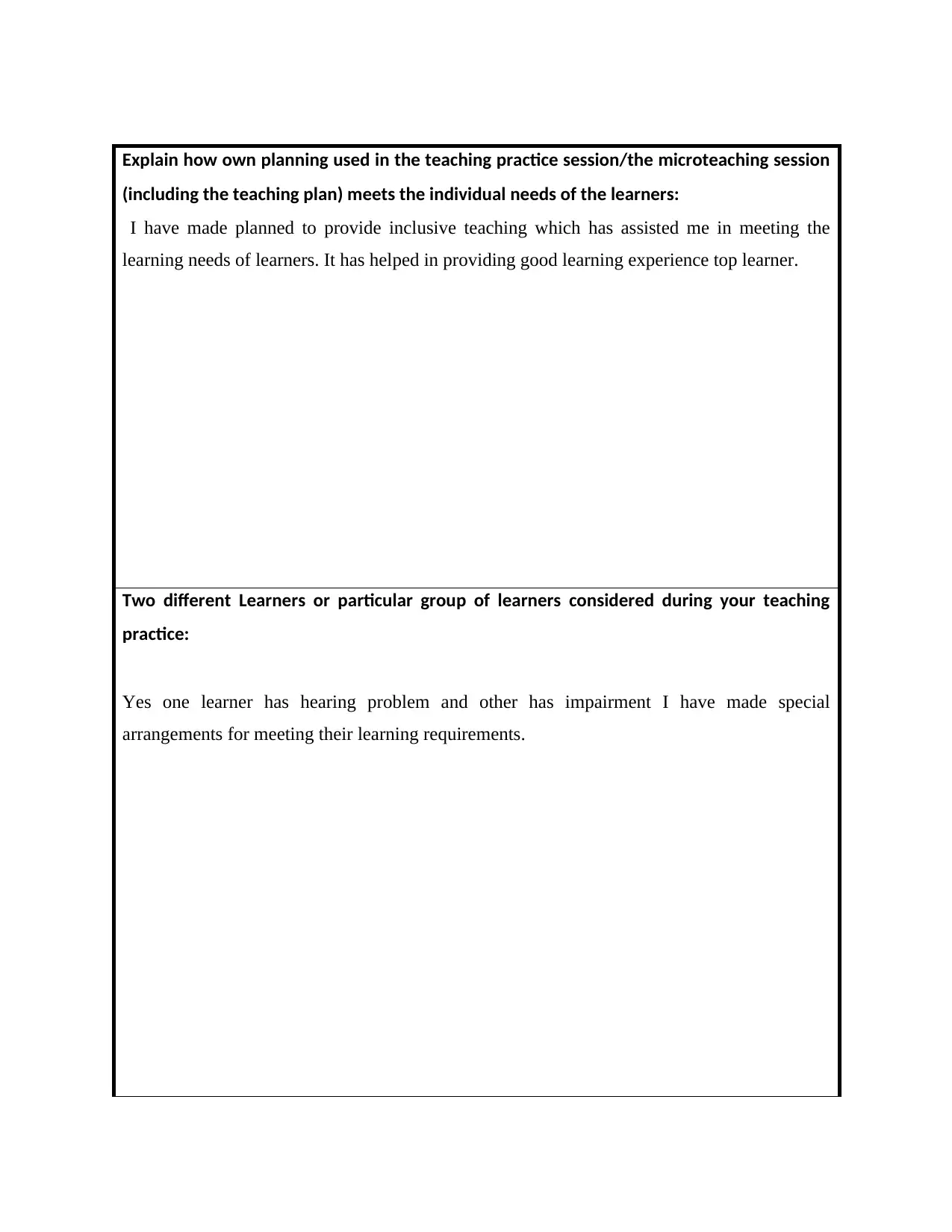
Explain how own planning used in the teaching practice session/the microteaching session
(including the teaching plan) meets the individual needs of the learners:
I have made planned to provide inclusive teaching which has assisted me in meeting the
learning needs of learners. It has helped in providing good learning experience top learner.
Two different Learners or particular group of learners considered during your teaching
practice:
Yes one learner has hearing problem and other has impairment I have made special
arrangements for meeting their learning requirements.
(including the teaching plan) meets the individual needs of the learners:
I have made planned to provide inclusive teaching which has assisted me in meeting the
learning needs of learners. It has helped in providing good learning experience top learner.
Two different Learners or particular group of learners considered during your teaching
practice:
Yes one learner has hearing problem and other has impairment I have made special
arrangements for meeting their learning requirements.
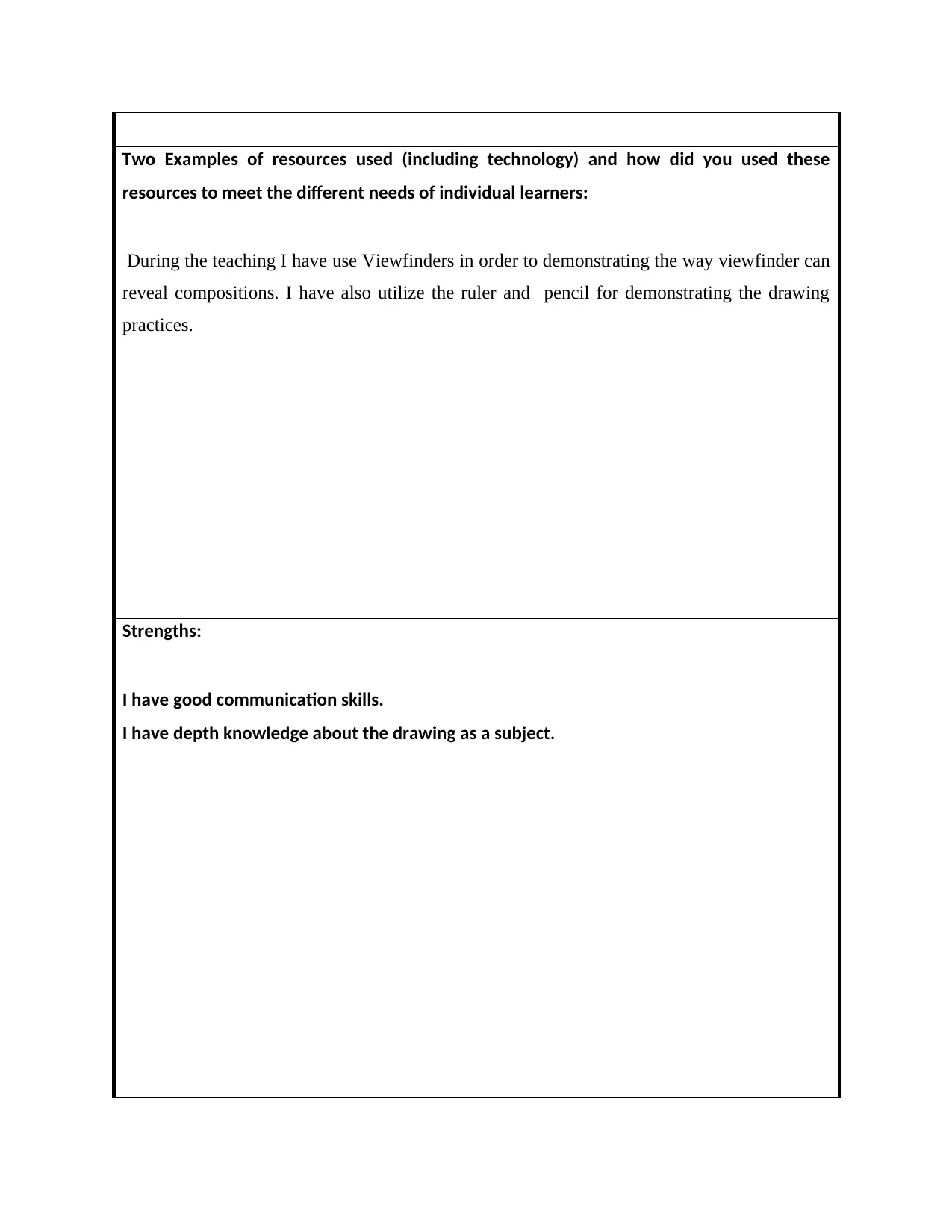
Two Examples of resources used (including technology) and how did you used these
resources to meet the different needs of individual learners:
During the teaching I have use Viewfinders in order to demonstrating the way viewfinder can
reveal compositions. I have also utilize the ruler and pencil for demonstrating the drawing
practices.
Strengths:
I have good communication skills.
I have depth knowledge about the drawing as a subject.
resources to meet the different needs of individual learners:
During the teaching I have use Viewfinders in order to demonstrating the way viewfinder can
reveal compositions. I have also utilize the ruler and pencil for demonstrating the drawing
practices.
Strengths:
I have good communication skills.
I have depth knowledge about the drawing as a subject.
Secure Best Marks with AI Grader
Need help grading? Try our AI Grader for instant feedback on your assignments.

Areas for development from the teaching practice:
I need to improve
I perceive that I need to develop more knowledge about teaching approaches, as this will assist
me in meeting the needs of learners.
Action required to improve the same session for the future:
I will seek support from peers and will take coaching in order to learn more about teaching
approaches.
I need to improve
I perceive that I need to develop more knowledge about teaching approaches, as this will assist
me in meeting the needs of learners.
Action required to improve the same session for the future:
I will seek support from peers and will take coaching in order to learn more about teaching
approaches.
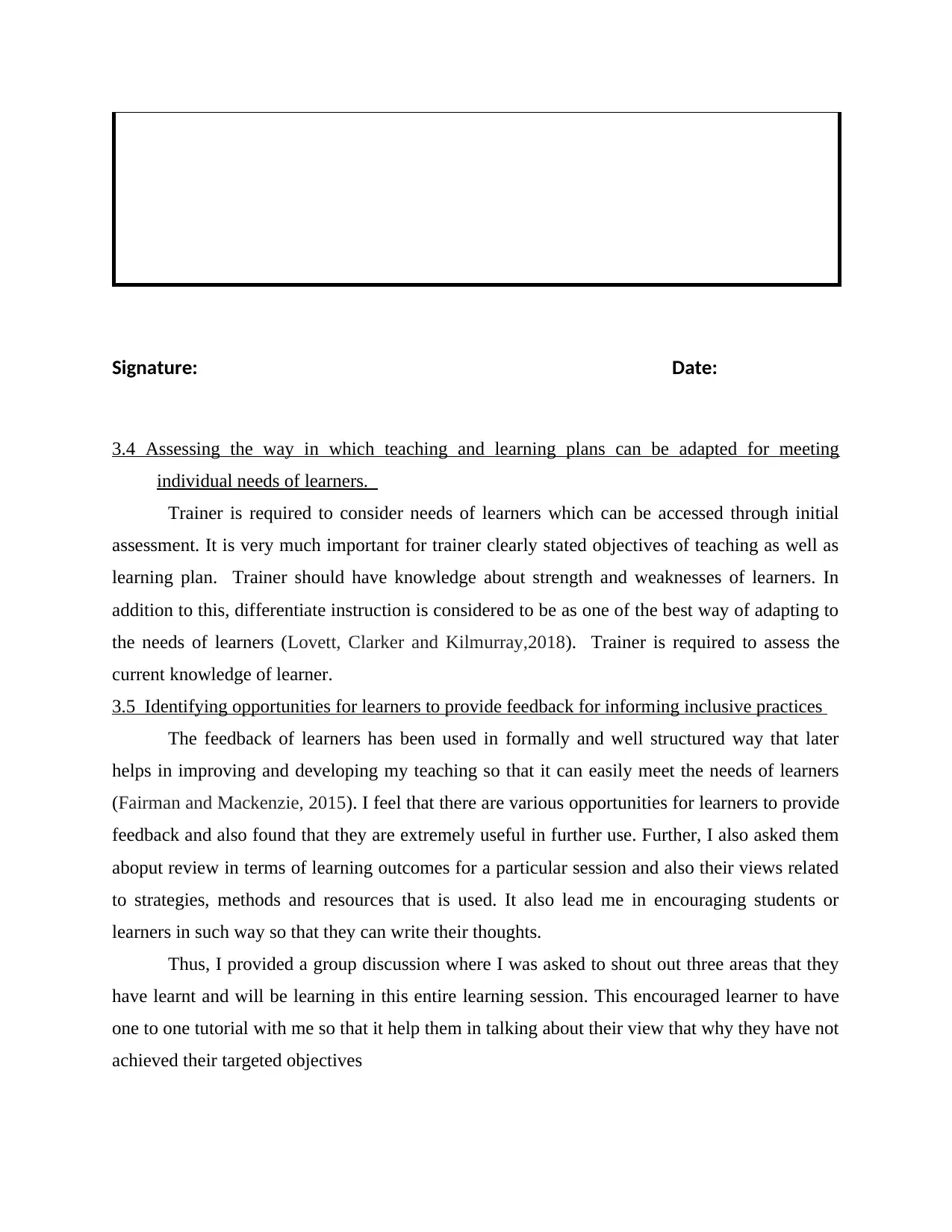
Signature: Date:
3.4 Assessing the way in which teaching and learning plans can be adapted for meeting
individual needs of learners.
Trainer is required to consider needs of learners which can be accessed through initial
assessment. It is very much important for trainer clearly stated objectives of teaching as well as
learning plan. Trainer should have knowledge about strength and weaknesses of learners. In
addition to this, differentiate instruction is considered to be as one of the best way of adapting to
the needs of learners (Lovett, Clarker and Kilmurray,2018). Trainer is required to assess the
current knowledge of learner.
3.5 Identifying opportunities for learners to provide feedback for informing inclusive practices
The feedback of learners has been used in formally and well structured way that later
helps in improving and developing my teaching so that it can easily meet the needs of learners
(Fairman and Mackenzie, 2015). I feel that there are various opportunities for learners to provide
feedback and also found that they are extremely useful in further use. Further, I also asked them
aboput review in terms of learning outcomes for a particular session and also their views related
to strategies, methods and resources that is used. It also lead me in encouraging students or
learners in such way so that they can write their thoughts.
Thus, I provided a group discussion where I was asked to shout out three areas that they
have learnt and will be learning in this entire learning session. This encouraged learner to have
one to one tutorial with me so that it help them in talking about their view that why they have not
achieved their targeted objectives
3.4 Assessing the way in which teaching and learning plans can be adapted for meeting
individual needs of learners.
Trainer is required to consider needs of learners which can be accessed through initial
assessment. It is very much important for trainer clearly stated objectives of teaching as well as
learning plan. Trainer should have knowledge about strength and weaknesses of learners. In
addition to this, differentiate instruction is considered to be as one of the best way of adapting to
the needs of learners (Lovett, Clarker and Kilmurray,2018). Trainer is required to assess the
current knowledge of learner.
3.5 Identifying opportunities for learners to provide feedback for informing inclusive practices
The feedback of learners has been used in formally and well structured way that later
helps in improving and developing my teaching so that it can easily meet the needs of learners
(Fairman and Mackenzie, 2015). I feel that there are various opportunities for learners to provide
feedback and also found that they are extremely useful in further use. Further, I also asked them
aboput review in terms of learning outcomes for a particular session and also their views related
to strategies, methods and resources that is used. It also lead me in encouraging students or
learners in such way so that they can write their thoughts.
Thus, I provided a group discussion where I was asked to shout out three areas that they
have learnt and will be learning in this entire learning session. This encouraged learner to have
one to one tutorial with me so that it help them in talking about their view that why they have not
achieved their targeted objectives
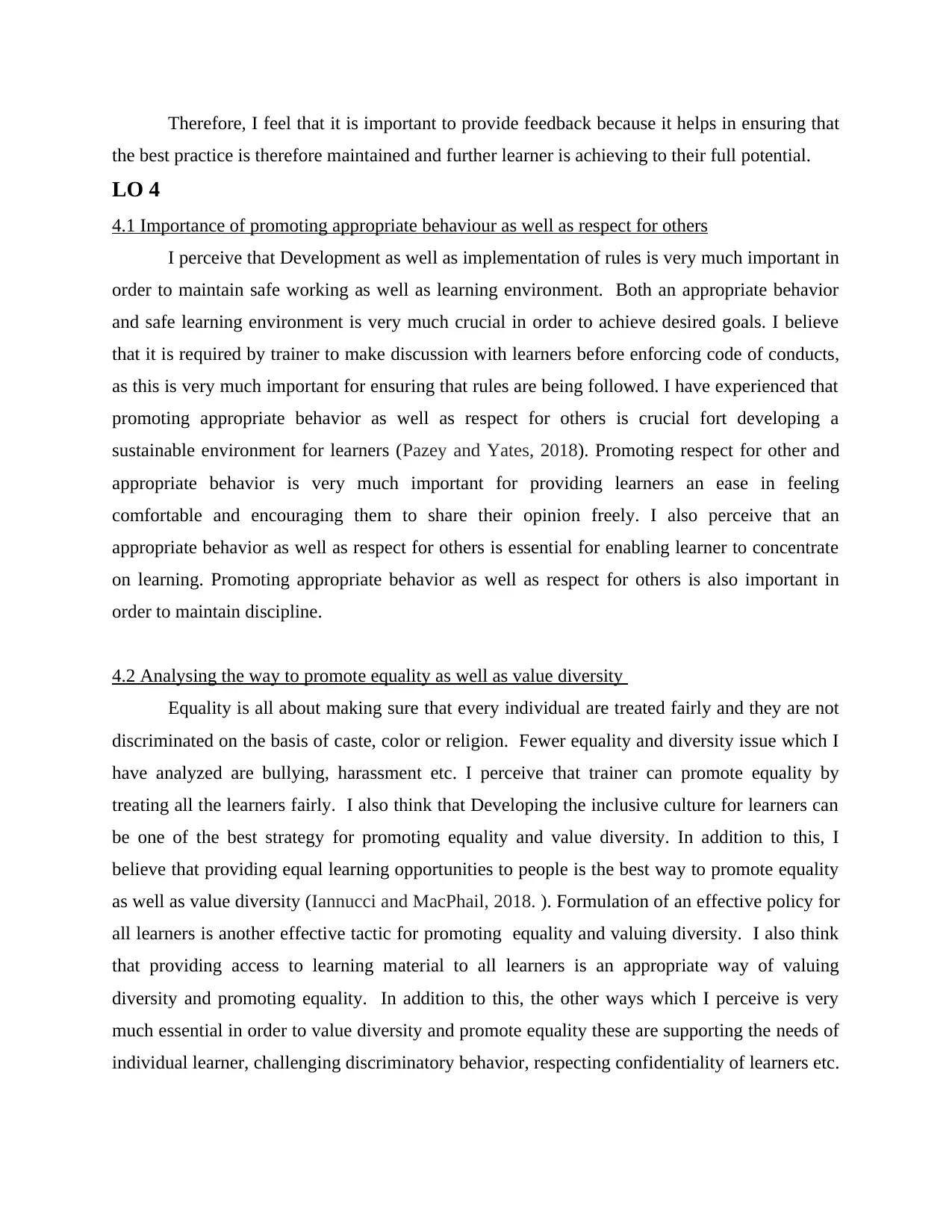
Therefore, I feel that it is important to provide feedback because it helps in ensuring that
the best practice is therefore maintained and further learner is achieving to their full potential.
LO 4
4.1 Importance of promoting appropriate behaviour as well as respect for others
I perceive that Development as well as implementation of rules is very much important in
order to maintain safe working as well as learning environment. Both an appropriate behavior
and safe learning environment is very much crucial in order to achieve desired goals. I believe
that it is required by trainer to make discussion with learners before enforcing code of conducts,
as this is very much important for ensuring that rules are being followed. I have experienced that
promoting appropriate behavior as well as respect for others is crucial fort developing a
sustainable environment for learners (Pazey and Yates, 2018). Promoting respect for other and
appropriate behavior is very much important for providing learners an ease in feeling
comfortable and encouraging them to share their opinion freely. I also perceive that an
appropriate behavior as well as respect for others is essential for enabling learner to concentrate
on learning. Promoting appropriate behavior as well as respect for others is also important in
order to maintain discipline.
4.2 Analysing the way to promote equality as well as value diversity
Equality is all about making sure that every individual are treated fairly and they are not
discriminated on the basis of caste, color or religion. Fewer equality and diversity issue which I
have analyzed are bullying, harassment etc. I perceive that trainer can promote equality by
treating all the learners fairly. I also think that Developing the inclusive culture for learners can
be one of the best strategy for promoting equality and value diversity. In addition to this, I
believe that providing equal learning opportunities to people is the best way to promote equality
as well as value diversity (Iannucci and MacPhail, 2018. ). Formulation of an effective policy for
all learners is another effective tactic for promoting equality and valuing diversity. I also think
that providing access to learning material to all learners is an appropriate way of valuing
diversity and promoting equality. In addition to this, the other ways which I perceive is very
much essential in order to value diversity and promote equality these are supporting the needs of
individual learner, challenging discriminatory behavior, respecting confidentiality of learners etc.
the best practice is therefore maintained and further learner is achieving to their full potential.
LO 4
4.1 Importance of promoting appropriate behaviour as well as respect for others
I perceive that Development as well as implementation of rules is very much important in
order to maintain safe working as well as learning environment. Both an appropriate behavior
and safe learning environment is very much crucial in order to achieve desired goals. I believe
that it is required by trainer to make discussion with learners before enforcing code of conducts,
as this is very much important for ensuring that rules are being followed. I have experienced that
promoting appropriate behavior as well as respect for others is crucial fort developing a
sustainable environment for learners (Pazey and Yates, 2018). Promoting respect for other and
appropriate behavior is very much important for providing learners an ease in feeling
comfortable and encouraging them to share their opinion freely. I also perceive that an
appropriate behavior as well as respect for others is essential for enabling learner to concentrate
on learning. Promoting appropriate behavior as well as respect for others is also important in
order to maintain discipline.
4.2 Analysing the way to promote equality as well as value diversity
Equality is all about making sure that every individual are treated fairly and they are not
discriminated on the basis of caste, color or religion. Fewer equality and diversity issue which I
have analyzed are bullying, harassment etc. I perceive that trainer can promote equality by
treating all the learners fairly. I also think that Developing the inclusive culture for learners can
be one of the best strategy for promoting equality and value diversity. In addition to this, I
believe that providing equal learning opportunities to people is the best way to promote equality
as well as value diversity (Iannucci and MacPhail, 2018. ). Formulation of an effective policy for
all learners is another effective tactic for promoting equality and valuing diversity. I also think
that providing access to learning material to all learners is an appropriate way of valuing
diversity and promoting equality. In addition to this, the other ways which I perceive is very
much essential in order to value diversity and promote equality these are supporting the needs of
individual learner, challenging discriminatory behavior, respecting confidentiality of learners etc.
Paraphrase This Document
Need a fresh take? Get an instant paraphrase of this document with our AI Paraphraser

I also think that trainer can promote equality as well as value diversity by enabling all learners to
participate in discussions.
4.3 Establishing and sustaining a safe, inclusive learning environment.
Inclusive learning environment is that in which members those who are involved feel
respected and connected to each other (Darling-Hammond, and et.al., 2015). Thus, ways in
which safe inclusive learning environment can be established has been discussed as per below
context-
Relationships- the most effective way in order to create an inclusive learning
environment which basically comes and grows with help of forming connections with
students in meaningful way. Thus, for building good relationship, time honoured
techniques can be used in which teachers must not raise their voice and also try to remind
their names in correct manner. In addition to this, they must also try to take extra efforts
and time that will help them in knowing every individual deeply and also make them
believe that everyone can get success.
Differentiating- everyone has habit of learning things in different way. Therefore,
students must be allowed to learn in their own way and make them engage with
information in various formats. This formats can be either websites, videos or podcasts.
This helps students in showcasing their ability in various ways and increase their
motivation level in terms of learning. This will also help them in improving their
understanding of topics for which they were struggling.
LO 5
5.1 Analysing effectiveness of teaching and learning approaches used in own area of specialism
in relation to meeting the individual needs of learners.
The initial stage is to identify individual needs of learner in terms of achieving the
targeted goals and also to promote learning (Afflerbach, 2017). Thus, teaching and learning
approaches that can be used in my area of specialism so that learner needs can be met has been
discussed as per below context-
Vocational standards- this is that type of education which basically helps people to
prepare themselves so that they can work in various jobs. It is also known as education
that is related to career. This will help me in creating specialism in particular field and
participate in discussions.
4.3 Establishing and sustaining a safe, inclusive learning environment.
Inclusive learning environment is that in which members those who are involved feel
respected and connected to each other (Darling-Hammond, and et.al., 2015). Thus, ways in
which safe inclusive learning environment can be established has been discussed as per below
context-
Relationships- the most effective way in order to create an inclusive learning
environment which basically comes and grows with help of forming connections with
students in meaningful way. Thus, for building good relationship, time honoured
techniques can be used in which teachers must not raise their voice and also try to remind
their names in correct manner. In addition to this, they must also try to take extra efforts
and time that will help them in knowing every individual deeply and also make them
believe that everyone can get success.
Differentiating- everyone has habit of learning things in different way. Therefore,
students must be allowed to learn in their own way and make them engage with
information in various formats. This formats can be either websites, videos or podcasts.
This helps students in showcasing their ability in various ways and increase their
motivation level in terms of learning. This will also help them in improving their
understanding of topics for which they were struggling.
LO 5
5.1 Analysing effectiveness of teaching and learning approaches used in own area of specialism
in relation to meeting the individual needs of learners.
The initial stage is to identify individual needs of learner in terms of achieving the
targeted goals and also to promote learning (Afflerbach, 2017). Thus, teaching and learning
approaches that can be used in my area of specialism so that learner needs can be met has been
discussed as per below context-
Vocational standards- this is that type of education which basically helps people to
prepare themselves so that they can work in various jobs. It is also known as education
that is related to career. This will help me in creating specialism in particular field and
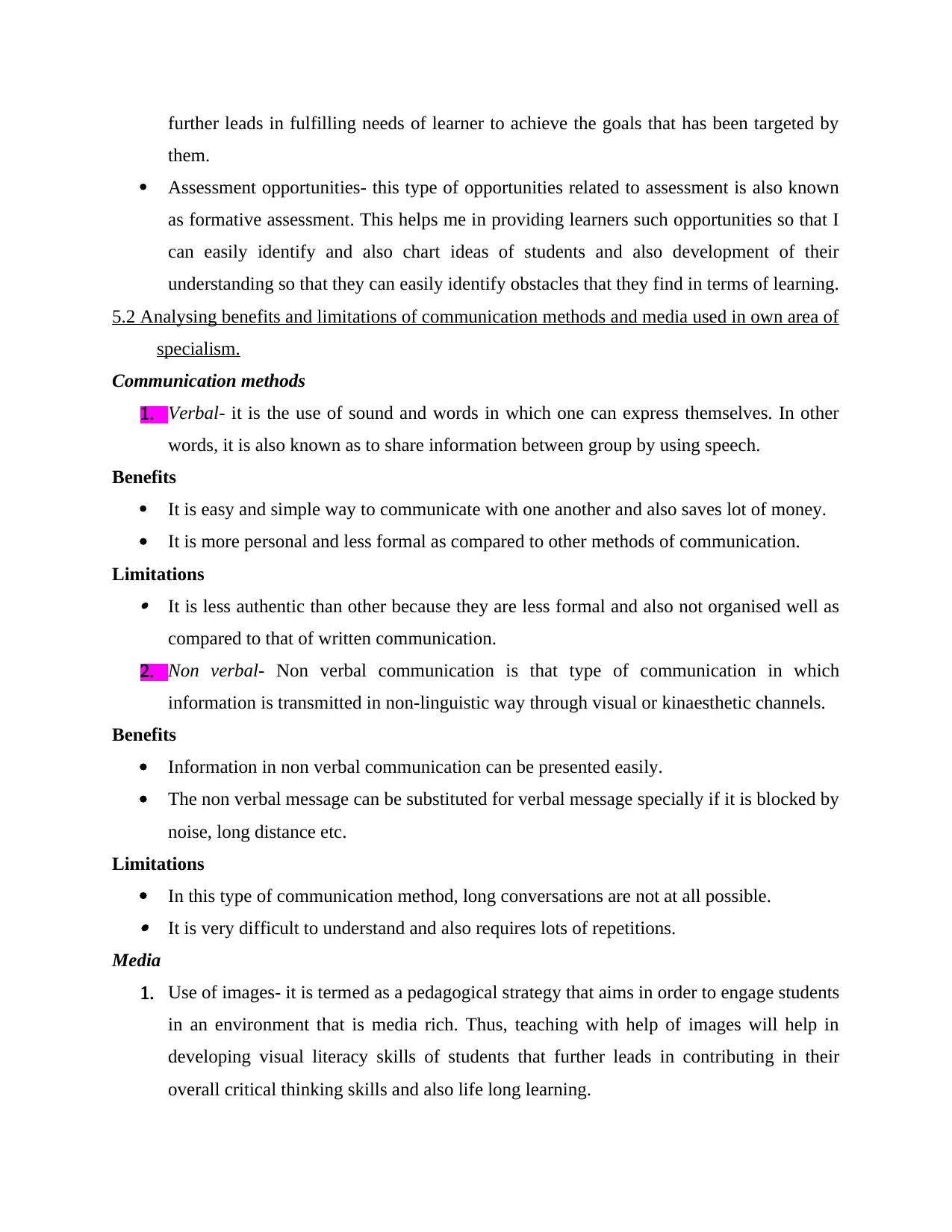
further leads in fulfilling needs of learner to achieve the goals that has been targeted by
them.
Assessment opportunities- this type of opportunities related to assessment is also known
as formative assessment. This helps me in providing learners such opportunities so that I
can easily identify and also chart ideas of students and also development of their
understanding so that they can easily identify obstacles that they find in terms of learning.
5.2 Analysing benefits and limitations of communication methods and media used in own area of
specialism.
Communication methods
1. Verbal- it is the use of sound and words in which one can express themselves. In other
words, it is also known as to share information between group by using speech.
Benefits
It is easy and simple way to communicate with one another and also saves lot of money.
It is more personal and less formal as compared to other methods of communication.
Limitations It is less authentic than other because they are less formal and also not organised well as
compared to that of written communication.
2. Non verbal- Non verbal communication is that type of communication in which
information is transmitted in non-linguistic way through visual or kinaesthetic channels.
Benefits
Information in non verbal communication can be presented easily.
The non verbal message can be substituted for verbal message specially if it is blocked by
noise, long distance etc.
Limitations
In this type of communication method, long conversations are not at all possible. It is very difficult to understand and also requires lots of repetitions.
Media
1. Use of images- it is termed as a pedagogical strategy that aims in order to engage students
in an environment that is media rich. Thus, teaching with help of images will help in
developing visual literacy skills of students that further leads in contributing in their
overall critical thinking skills and also life long learning.
them.
Assessment opportunities- this type of opportunities related to assessment is also known
as formative assessment. This helps me in providing learners such opportunities so that I
can easily identify and also chart ideas of students and also development of their
understanding so that they can easily identify obstacles that they find in terms of learning.
5.2 Analysing benefits and limitations of communication methods and media used in own area of
specialism.
Communication methods
1. Verbal- it is the use of sound and words in which one can express themselves. In other
words, it is also known as to share information between group by using speech.
Benefits
It is easy and simple way to communicate with one another and also saves lot of money.
It is more personal and less formal as compared to other methods of communication.
Limitations It is less authentic than other because they are less formal and also not organised well as
compared to that of written communication.
2. Non verbal- Non verbal communication is that type of communication in which
information is transmitted in non-linguistic way through visual or kinaesthetic channels.
Benefits
Information in non verbal communication can be presented easily.
The non verbal message can be substituted for verbal message specially if it is blocked by
noise, long distance etc.
Limitations
In this type of communication method, long conversations are not at all possible. It is very difficult to understand and also requires lots of repetitions.
Media
1. Use of images- it is termed as a pedagogical strategy that aims in order to engage students
in an environment that is media rich. Thus, teaching with help of images will help in
developing visual literacy skills of students that further leads in contributing in their
overall critical thinking skills and also life long learning.
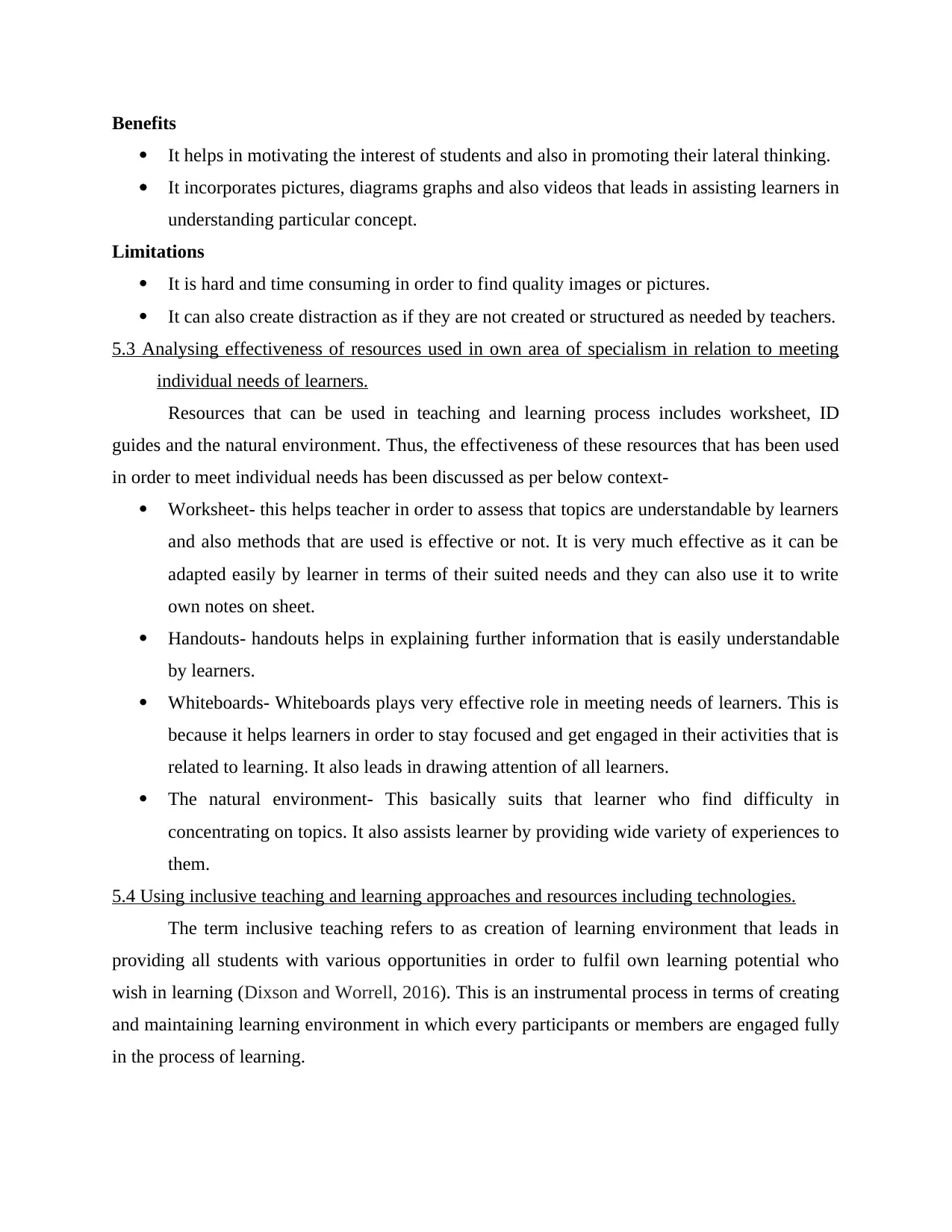
Benefits
It helps in motivating the interest of students and also in promoting their lateral thinking.
It incorporates pictures, diagrams graphs and also videos that leads in assisting learners in
understanding particular concept.
Limitations
It is hard and time consuming in order to find quality images or pictures.
It can also create distraction as if they are not created or structured as needed by teachers.
5.3 Analysing effectiveness of resources used in own area of specialism in relation to meeting
individual needs of learners.
Resources that can be used in teaching and learning process includes worksheet, ID
guides and the natural environment. Thus, the effectiveness of these resources that has been used
in order to meet individual needs has been discussed as per below context-
Worksheet- this helps teacher in order to assess that topics are understandable by learners
and also methods that are used is effective or not. It is very much effective as it can be
adapted easily by learner in terms of their suited needs and they can also use it to write
own notes on sheet.
Handouts- handouts helps in explaining further information that is easily understandable
by learners.
Whiteboards- Whiteboards plays very effective role in meeting needs of learners. This is
because it helps learners in order to stay focused and get engaged in their activities that is
related to learning. It also leads in drawing attention of all learners.
The natural environment- This basically suits that learner who find difficulty in
concentrating on topics. It also assists learner by providing wide variety of experiences to
them.
5.4 Using inclusive teaching and learning approaches and resources including technologies.
The term inclusive teaching refers to as creation of learning environment that leads in
providing all students with various opportunities in order to fulfil own learning potential who
wish in learning (Dixson and Worrell, 2016). This is an instrumental process in terms of creating
and maintaining learning environment in which every participants or members are engaged fully
in the process of learning.
It helps in motivating the interest of students and also in promoting their lateral thinking.
It incorporates pictures, diagrams graphs and also videos that leads in assisting learners in
understanding particular concept.
Limitations
It is hard and time consuming in order to find quality images or pictures.
It can also create distraction as if they are not created or structured as needed by teachers.
5.3 Analysing effectiveness of resources used in own area of specialism in relation to meeting
individual needs of learners.
Resources that can be used in teaching and learning process includes worksheet, ID
guides and the natural environment. Thus, the effectiveness of these resources that has been used
in order to meet individual needs has been discussed as per below context-
Worksheet- this helps teacher in order to assess that topics are understandable by learners
and also methods that are used is effective or not. It is very much effective as it can be
adapted easily by learner in terms of their suited needs and they can also use it to write
own notes on sheet.
Handouts- handouts helps in explaining further information that is easily understandable
by learners.
Whiteboards- Whiteboards plays very effective role in meeting needs of learners. This is
because it helps learners in order to stay focused and get engaged in their activities that is
related to learning. It also leads in drawing attention of all learners.
The natural environment- This basically suits that learner who find difficulty in
concentrating on topics. It also assists learner by providing wide variety of experiences to
them.
5.4 Using inclusive teaching and learning approaches and resources including technologies.
The term inclusive teaching refers to as creation of learning environment that leads in
providing all students with various opportunities in order to fulfil own learning potential who
wish in learning (Dixson and Worrell, 2016). This is an instrumental process in terms of creating
and maintaining learning environment in which every participants or members are engaged fully
in the process of learning.
Secure Best Marks with AI Grader
Need help grading? Try our AI Grader for instant feedback on your assignments.
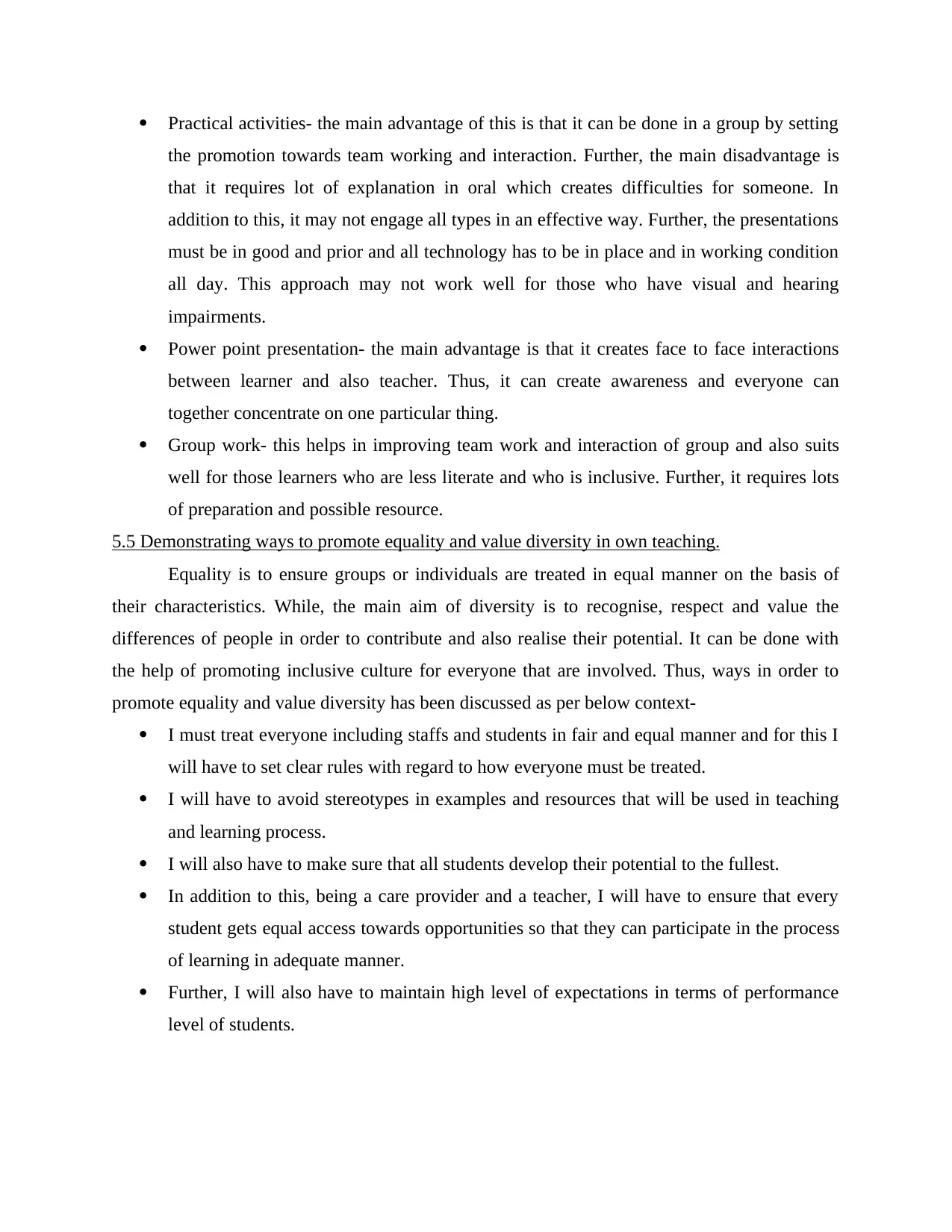
Practical activities- the main advantage of this is that it can be done in a group by setting
the promotion towards team working and interaction. Further, the main disadvantage is
that it requires lot of explanation in oral which creates difficulties for someone. In
addition to this, it may not engage all types in an effective way. Further, the presentations
must be in good and prior and all technology has to be in place and in working condition
all day. This approach may not work well for those who have visual and hearing
impairments.
Power point presentation- the main advantage is that it creates face to face interactions
between learner and also teacher. Thus, it can create awareness and everyone can
together concentrate on one particular thing.
Group work- this helps in improving team work and interaction of group and also suits
well for those learners who are less literate and who is inclusive. Further, it requires lots
of preparation and possible resource.
5.5 Demonstrating ways to promote equality and value diversity in own teaching.
Equality is to ensure groups or individuals are treated in equal manner on the basis of
their characteristics. While, the main aim of diversity is to recognise, respect and value the
differences of people in order to contribute and also realise their potential. It can be done with
the help of promoting inclusive culture for everyone that are involved. Thus, ways in order to
promote equality and value diversity has been discussed as per below context-
I must treat everyone including staffs and students in fair and equal manner and for this I
will have to set clear rules with regard to how everyone must be treated.
I will have to avoid stereotypes in examples and resources that will be used in teaching
and learning process.
I will also have to make sure that all students develop their potential to the fullest.
In addition to this, being a care provider and a teacher, I will have to ensure that every
student gets equal access towards opportunities so that they can participate in the process
of learning in adequate manner.
Further, I will also have to maintain high level of expectations in terms of performance
level of students.
the promotion towards team working and interaction. Further, the main disadvantage is
that it requires lot of explanation in oral which creates difficulties for someone. In
addition to this, it may not engage all types in an effective way. Further, the presentations
must be in good and prior and all technology has to be in place and in working condition
all day. This approach may not work well for those who have visual and hearing
impairments.
Power point presentation- the main advantage is that it creates face to face interactions
between learner and also teacher. Thus, it can create awareness and everyone can
together concentrate on one particular thing.
Group work- this helps in improving team work and interaction of group and also suits
well for those learners who are less literate and who is inclusive. Further, it requires lots
of preparation and possible resource.
5.5 Demonstrating ways to promote equality and value diversity in own teaching.
Equality is to ensure groups or individuals are treated in equal manner on the basis of
their characteristics. While, the main aim of diversity is to recognise, respect and value the
differences of people in order to contribute and also realise their potential. It can be done with
the help of promoting inclusive culture for everyone that are involved. Thus, ways in order to
promote equality and value diversity has been discussed as per below context-
I must treat everyone including staffs and students in fair and equal manner and for this I
will have to set clear rules with regard to how everyone must be treated.
I will have to avoid stereotypes in examples and resources that will be used in teaching
and learning process.
I will also have to make sure that all students develop their potential to the fullest.
In addition to this, being a care provider and a teacher, I will have to ensure that every
student gets equal access towards opportunities so that they can participate in the process
of learning in adequate manner.
Further, I will also have to maintain high level of expectations in terms of performance
level of students.
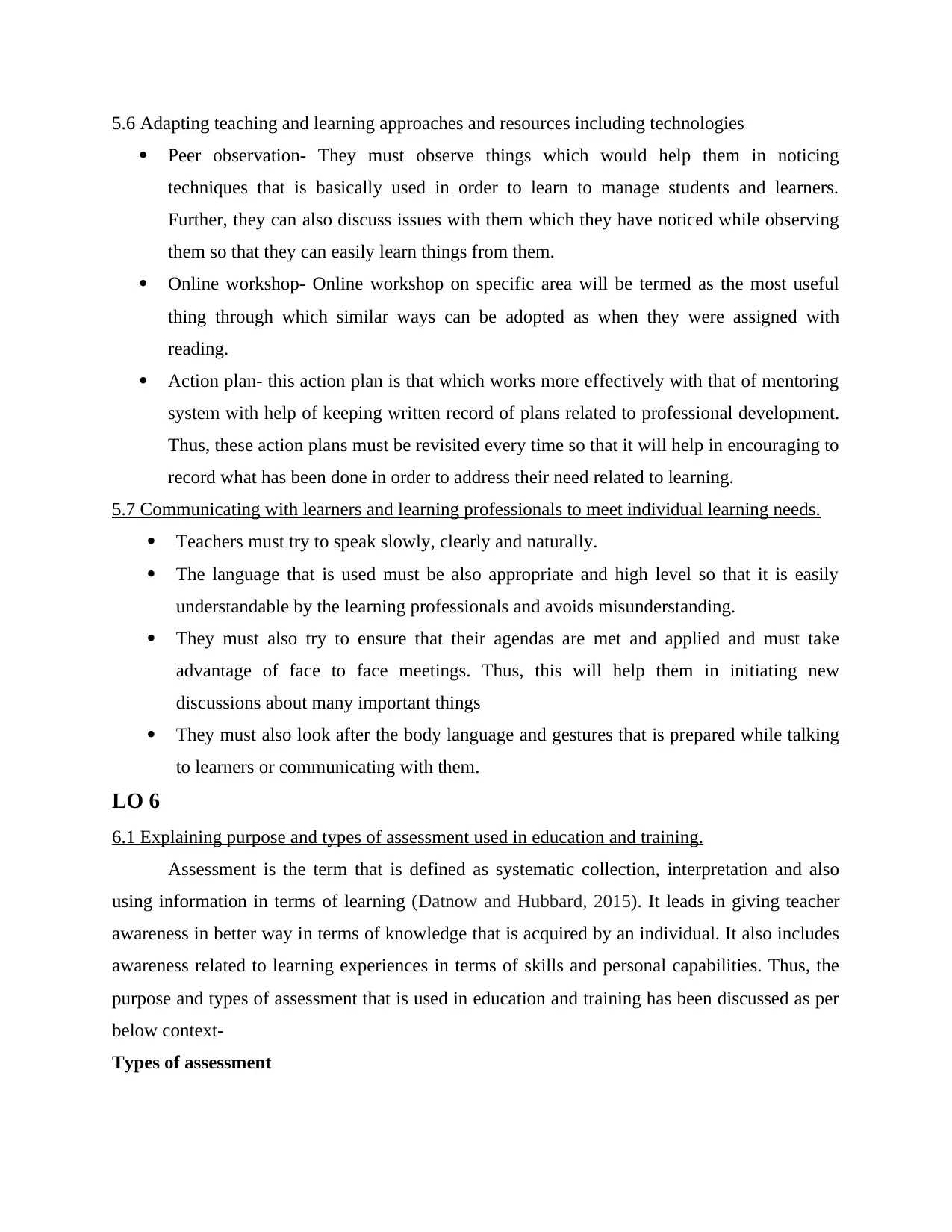
5.6 Adapting teaching and learning approaches and resources including technologies
Peer observation- They must observe things which would help them in noticing
techniques that is basically used in order to learn to manage students and learners.
Further, they can also discuss issues with them which they have noticed while observing
them so that they can easily learn things from them.
Online workshop- Online workshop on specific area will be termed as the most useful
thing through which similar ways can be adopted as when they were assigned with
reading.
Action plan- this action plan is that which works more effectively with that of mentoring
system with help of keeping written record of plans related to professional development.
Thus, these action plans must be revisited every time so that it will help in encouraging to
record what has been done in order to address their need related to learning.
5.7 Communicating with learners and learning professionals to meet individual learning needs.
Teachers must try to speak slowly, clearly and naturally.
The language that is used must be also appropriate and high level so that it is easily
understandable by the learning professionals and avoids misunderstanding.
They must also try to ensure that their agendas are met and applied and must take
advantage of face to face meetings. Thus, this will help them in initiating new
discussions about many important things
They must also look after the body language and gestures that is prepared while talking
to learners or communicating with them.
LO 6
6.1 Explaining purpose and types of assessment used in education and training.
Assessment is the term that is defined as systematic collection, interpretation and also
using information in terms of learning (Datnow and Hubbard, 2015). It leads in giving teacher
awareness in better way in terms of knowledge that is acquired by an individual. It also includes
awareness related to learning experiences in terms of skills and personal capabilities. Thus, the
purpose and types of assessment that is used in education and training has been discussed as per
below context-
Types of assessment
Peer observation- They must observe things which would help them in noticing
techniques that is basically used in order to learn to manage students and learners.
Further, they can also discuss issues with them which they have noticed while observing
them so that they can easily learn things from them.
Online workshop- Online workshop on specific area will be termed as the most useful
thing through which similar ways can be adopted as when they were assigned with
reading.
Action plan- this action plan is that which works more effectively with that of mentoring
system with help of keeping written record of plans related to professional development.
Thus, these action plans must be revisited every time so that it will help in encouraging to
record what has been done in order to address their need related to learning.
5.7 Communicating with learners and learning professionals to meet individual learning needs.
Teachers must try to speak slowly, clearly and naturally.
The language that is used must be also appropriate and high level so that it is easily
understandable by the learning professionals and avoids misunderstanding.
They must also try to ensure that their agendas are met and applied and must take
advantage of face to face meetings. Thus, this will help them in initiating new
discussions about many important things
They must also look after the body language and gestures that is prepared while talking
to learners or communicating with them.
LO 6
6.1 Explaining purpose and types of assessment used in education and training.
Assessment is the term that is defined as systematic collection, interpretation and also
using information in terms of learning (Datnow and Hubbard, 2015). It leads in giving teacher
awareness in better way in terms of knowledge that is acquired by an individual. It also includes
awareness related to learning experiences in terms of skills and personal capabilities. Thus, the
purpose and types of assessment that is used in education and training has been discussed as per
below context-
Types of assessment
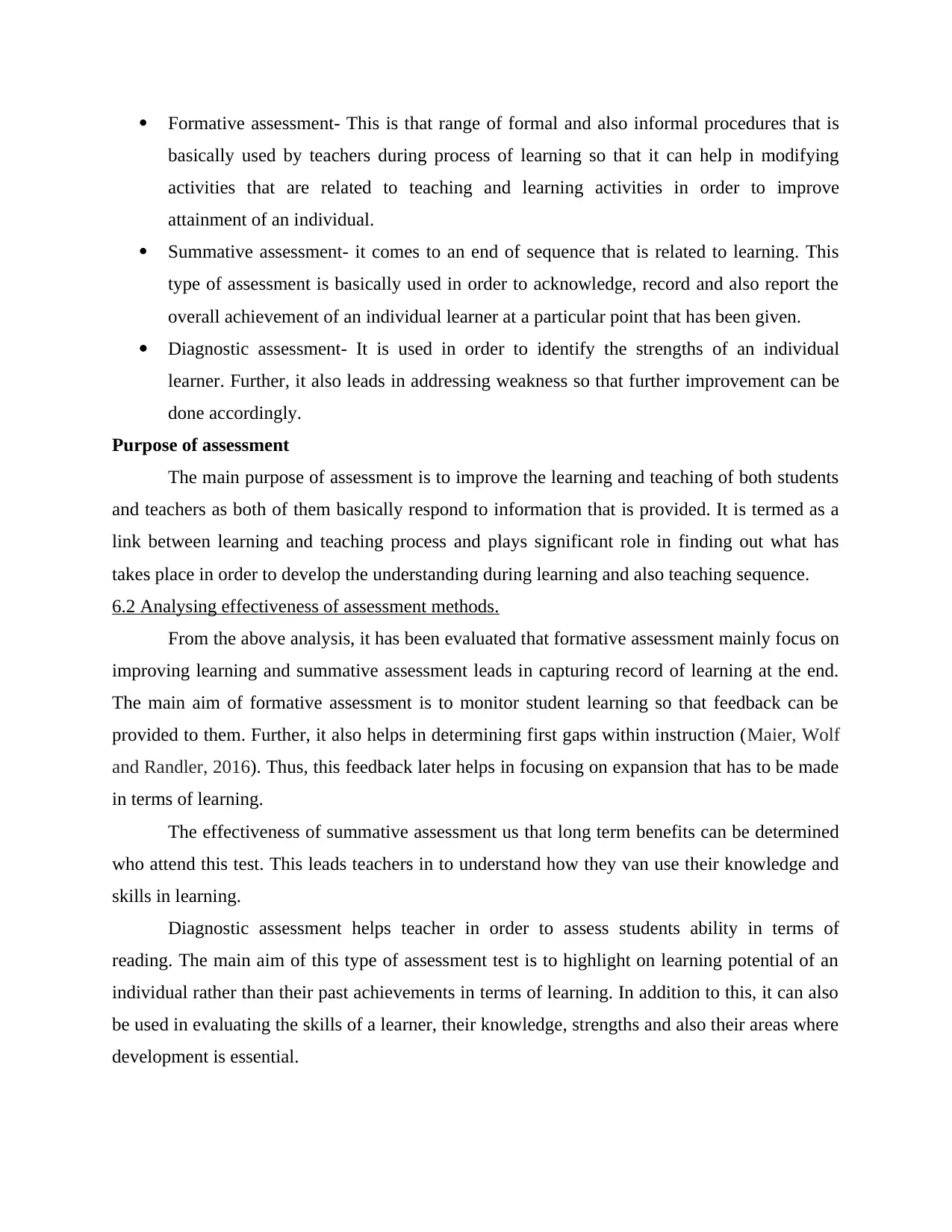
Formative assessment- This is that range of formal and also informal procedures that is
basically used by teachers during process of learning so that it can help in modifying
activities that are related to teaching and learning activities in order to improve
attainment of an individual.
Summative assessment- it comes to an end of sequence that is related to learning. This
type of assessment is basically used in order to acknowledge, record and also report the
overall achievement of an individual learner at a particular point that has been given.
Diagnostic assessment- It is used in order to identify the strengths of an individual
learner. Further, it also leads in addressing weakness so that further improvement can be
done accordingly.
Purpose of assessment
The main purpose of assessment is to improve the learning and teaching of both students
and teachers as both of them basically respond to information that is provided. It is termed as a
link between learning and teaching process and plays significant role in finding out what has
takes place in order to develop the understanding during learning and also teaching sequence.
6.2 Analysing effectiveness of assessment methods.
From the above analysis, it has been evaluated that formative assessment mainly focus on
improving learning and summative assessment leads in capturing record of learning at the end.
The main aim of formative assessment is to monitor student learning so that feedback can be
provided to them. Further, it also helps in determining first gaps within instruction (Maier, Wolf
and Randler, 2016). Thus, this feedback later helps in focusing on expansion that has to be made
in terms of learning.
The effectiveness of summative assessment us that long term benefits can be determined
who attend this test. This leads teachers in to understand how they van use their knowledge and
skills in learning.
Diagnostic assessment helps teacher in order to assess students ability in terms of
reading. The main aim of this type of assessment test is to highlight on learning potential of an
individual rather than their past achievements in terms of learning. In addition to this, it can also
be used in evaluating the skills of a learner, their knowledge, strengths and also their areas where
development is essential.
basically used by teachers during process of learning so that it can help in modifying
activities that are related to teaching and learning activities in order to improve
attainment of an individual.
Summative assessment- it comes to an end of sequence that is related to learning. This
type of assessment is basically used in order to acknowledge, record and also report the
overall achievement of an individual learner at a particular point that has been given.
Diagnostic assessment- It is used in order to identify the strengths of an individual
learner. Further, it also leads in addressing weakness so that further improvement can be
done accordingly.
Purpose of assessment
The main purpose of assessment is to improve the learning and teaching of both students
and teachers as both of them basically respond to information that is provided. It is termed as a
link between learning and teaching process and plays significant role in finding out what has
takes place in order to develop the understanding during learning and also teaching sequence.
6.2 Analysing effectiveness of assessment methods.
From the above analysis, it has been evaluated that formative assessment mainly focus on
improving learning and summative assessment leads in capturing record of learning at the end.
The main aim of formative assessment is to monitor student learning so that feedback can be
provided to them. Further, it also helps in determining first gaps within instruction (Maier, Wolf
and Randler, 2016). Thus, this feedback later helps in focusing on expansion that has to be made
in terms of learning.
The effectiveness of summative assessment us that long term benefits can be determined
who attend this test. This leads teachers in to understand how they van use their knowledge and
skills in learning.
Diagnostic assessment helps teacher in order to assess students ability in terms of
reading. The main aim of this type of assessment test is to highlight on learning potential of an
individual rather than their past achievements in terms of learning. In addition to this, it can also
be used in evaluating the skills of a learner, their knowledge, strengths and also their areas where
development is essential.
Paraphrase This Document
Need a fresh take? Get an instant paraphrase of this document with our AI Paraphraser
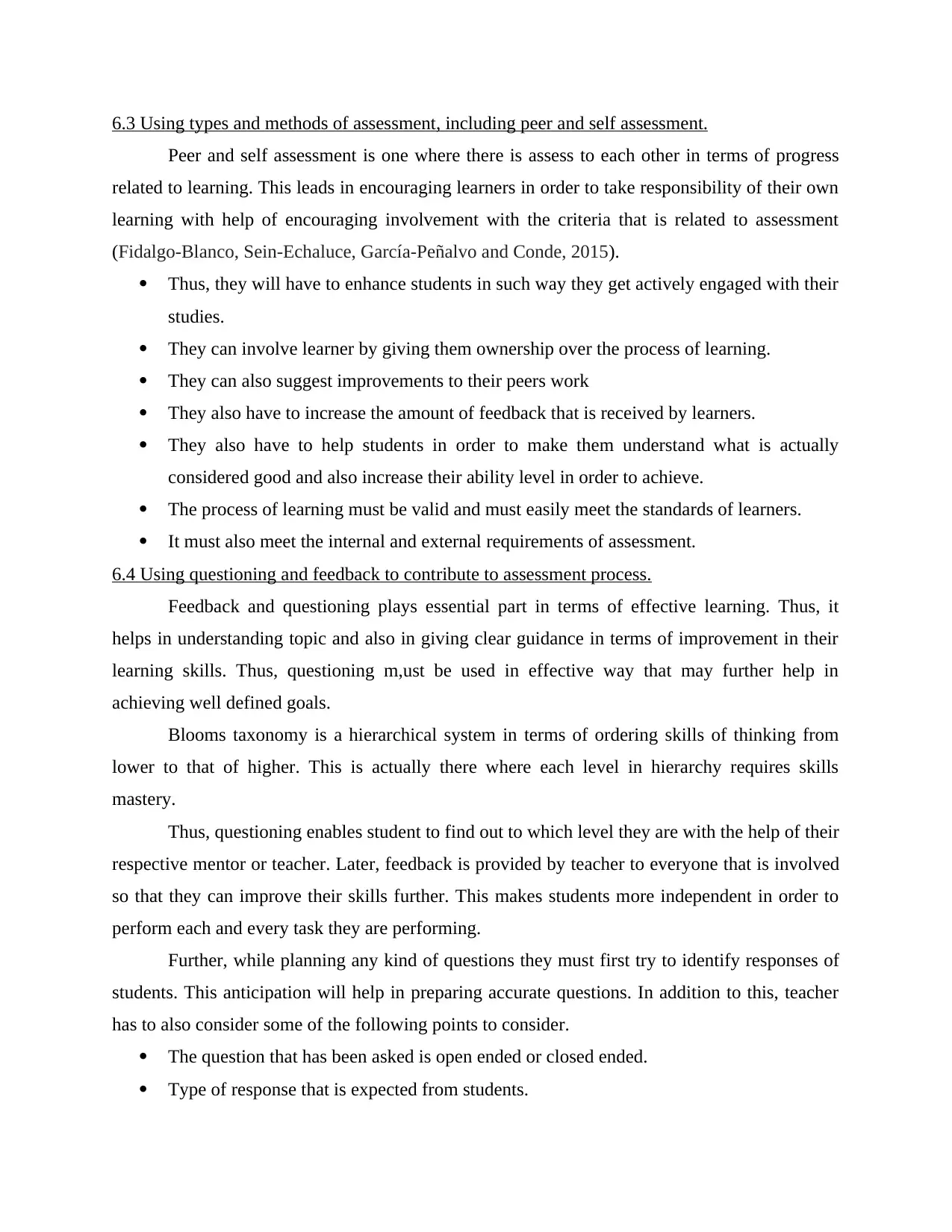
6.3 Using types and methods of assessment, including peer and self assessment.
Peer and self assessment is one where there is assess to each other in terms of progress
related to learning. This leads in encouraging learners in order to take responsibility of their own
learning with help of encouraging involvement with the criteria that is related to assessment
(Fidalgo-Blanco, Sein-Echaluce, García-Peñalvo and Conde, 2015).
Thus, they will have to enhance students in such way they get actively engaged with their
studies.
They can involve learner by giving them ownership over the process of learning.
They can also suggest improvements to their peers work
They also have to increase the amount of feedback that is received by learners.
They also have to help students in order to make them understand what is actually
considered good and also increase their ability level in order to achieve.
The process of learning must be valid and must easily meet the standards of learners.
It must also meet the internal and external requirements of assessment.
6.4 Using questioning and feedback to contribute to assessment process.
Feedback and questioning plays essential part in terms of effective learning. Thus, it
helps in understanding topic and also in giving clear guidance in terms of improvement in their
learning skills. Thus, questioning m,ust be used in effective way that may further help in
achieving well defined goals.
Blooms taxonomy is a hierarchical system in terms of ordering skills of thinking from
lower to that of higher. This is actually there where each level in hierarchy requires skills
mastery.
Thus, questioning enables student to find out to which level they are with the help of their
respective mentor or teacher. Later, feedback is provided by teacher to everyone that is involved
so that they can improve their skills further. This makes students more independent in order to
perform each and every task they are performing.
Further, while planning any kind of questions they must first try to identify responses of
students. This anticipation will help in preparing accurate questions. In addition to this, teacher
has to also consider some of the following points to consider.
The question that has been asked is open ended or closed ended.
Type of response that is expected from students.
Peer and self assessment is one where there is assess to each other in terms of progress
related to learning. This leads in encouraging learners in order to take responsibility of their own
learning with help of encouraging involvement with the criteria that is related to assessment
(Fidalgo-Blanco, Sein-Echaluce, García-Peñalvo and Conde, 2015).
Thus, they will have to enhance students in such way they get actively engaged with their
studies.
They can involve learner by giving them ownership over the process of learning.
They can also suggest improvements to their peers work
They also have to increase the amount of feedback that is received by learners.
They also have to help students in order to make them understand what is actually
considered good and also increase their ability level in order to achieve.
The process of learning must be valid and must easily meet the standards of learners.
It must also meet the internal and external requirements of assessment.
6.4 Using questioning and feedback to contribute to assessment process.
Feedback and questioning plays essential part in terms of effective learning. Thus, it
helps in understanding topic and also in giving clear guidance in terms of improvement in their
learning skills. Thus, questioning m,ust be used in effective way that may further help in
achieving well defined goals.
Blooms taxonomy is a hierarchical system in terms of ordering skills of thinking from
lower to that of higher. This is actually there where each level in hierarchy requires skills
mastery.
Thus, questioning enables student to find out to which level they are with the help of their
respective mentor or teacher. Later, feedback is provided by teacher to everyone that is involved
so that they can improve their skills further. This makes students more independent in order to
perform each and every task they are performing.
Further, while planning any kind of questions they must first try to identify responses of
students. This anticipation will help in preparing accurate questions. In addition to this, teacher
has to also consider some of the following points to consider.
The question that has been asked is open ended or closed ended.
Type of response that is expected from students.
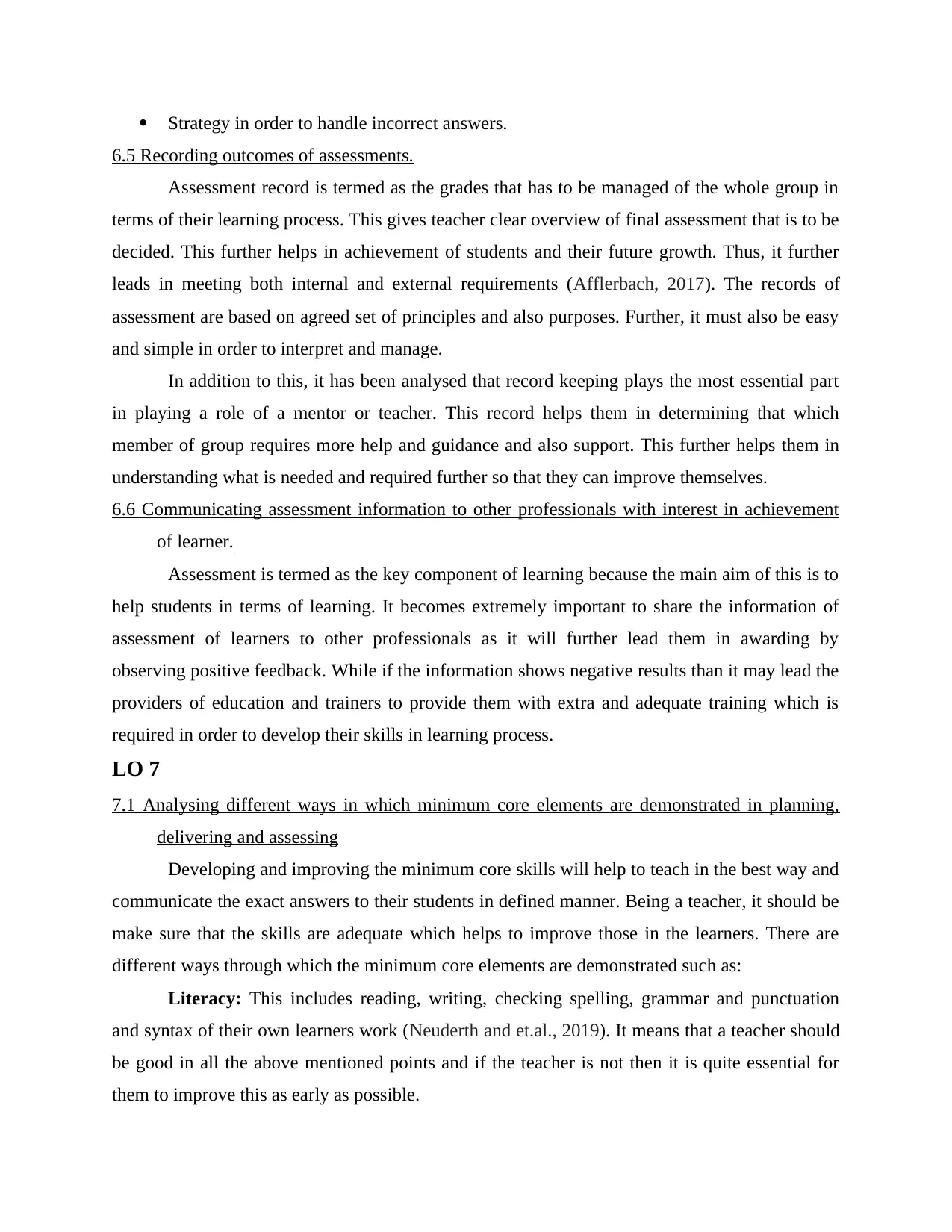
Strategy in order to handle incorrect answers.
6.5 Recording outcomes of assessments.
Assessment record is termed as the grades that has to be managed of the whole group in
terms of their learning process. This gives teacher clear overview of final assessment that is to be
decided. This further helps in achievement of students and their future growth. Thus, it further
leads in meeting both internal and external requirements (Afflerbach, 2017). The records of
assessment are based on agreed set of principles and also purposes. Further, it must also be easy
and simple in order to interpret and manage.
In addition to this, it has been analysed that record keeping plays the most essential part
in playing a role of a mentor or teacher. This record helps them in determining that which
member of group requires more help and guidance and also support. This further helps them in
understanding what is needed and required further so that they can improve themselves.
6.6 Communicating assessment information to other professionals with interest in achievement
of learner.
Assessment is termed as the key component of learning because the main aim of this is to
help students in terms of learning. It becomes extremely important to share the information of
assessment of learners to other professionals as it will further lead them in awarding by
observing positive feedback. While if the information shows negative results than it may lead the
providers of education and trainers to provide them with extra and adequate training which is
required in order to develop their skills in learning process.
LO 7
7.1 Analysing different ways in which minimum core elements are demonstrated in planning,
delivering and assessing
Developing and improving the minimum core skills will help to teach in the best way and
communicate the exact answers to their students in defined manner. Being a teacher, it should be
make sure that the skills are adequate which helps to improve those in the learners. There are
different ways through which the minimum core elements are demonstrated such as:
Literacy: This includes reading, writing, checking spelling, grammar and punctuation
and syntax of their own learners work (Neuderth and et.al., 2019). It means that a teacher should
be good in all the above mentioned points and if the teacher is not then it is quite essential for
them to improve this as early as possible.
6.5 Recording outcomes of assessments.
Assessment record is termed as the grades that has to be managed of the whole group in
terms of their learning process. This gives teacher clear overview of final assessment that is to be
decided. This further helps in achievement of students and their future growth. Thus, it further
leads in meeting both internal and external requirements (Afflerbach, 2017). The records of
assessment are based on agreed set of principles and also purposes. Further, it must also be easy
and simple in order to interpret and manage.
In addition to this, it has been analysed that record keeping plays the most essential part
in playing a role of a mentor or teacher. This record helps them in determining that which
member of group requires more help and guidance and also support. This further helps them in
understanding what is needed and required further so that they can improve themselves.
6.6 Communicating assessment information to other professionals with interest in achievement
of learner.
Assessment is termed as the key component of learning because the main aim of this is to
help students in terms of learning. It becomes extremely important to share the information of
assessment of learners to other professionals as it will further lead them in awarding by
observing positive feedback. While if the information shows negative results than it may lead the
providers of education and trainers to provide them with extra and adequate training which is
required in order to develop their skills in learning process.
LO 7
7.1 Analysing different ways in which minimum core elements are demonstrated in planning,
delivering and assessing
Developing and improving the minimum core skills will help to teach in the best way and
communicate the exact answers to their students in defined manner. Being a teacher, it should be
make sure that the skills are adequate which helps to improve those in the learners. There are
different ways through which the minimum core elements are demonstrated such as:
Literacy: This includes reading, writing, checking spelling, grammar and punctuation
and syntax of their own learners work (Neuderth and et.al., 2019). It means that a teacher should
be good in all the above mentioned points and if the teacher is not then it is quite essential for
them to improve this as early as possible.
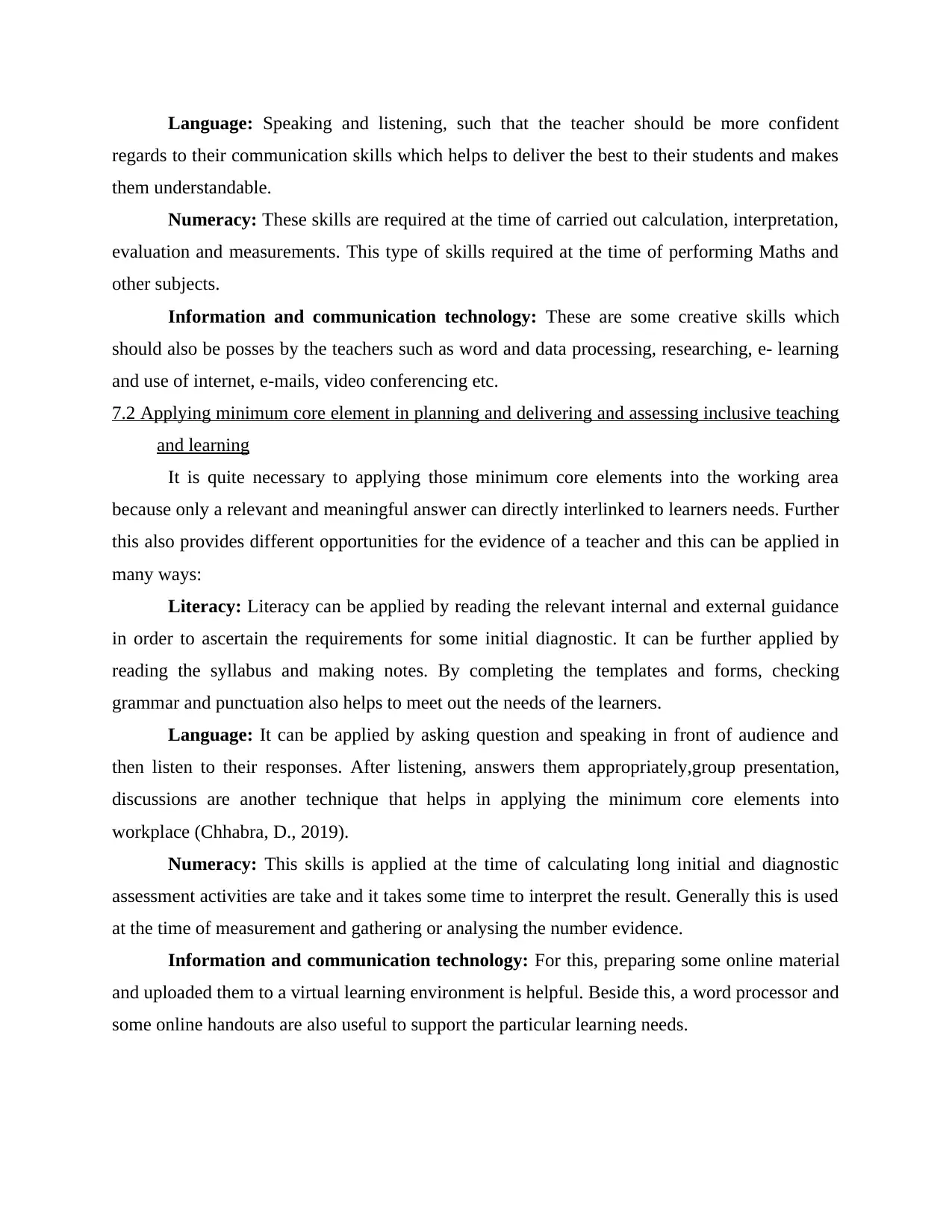
Language: Speaking and listening, such that the teacher should be more confident
regards to their communication skills which helps to deliver the best to their students and makes
them understandable.
Numeracy: These skills are required at the time of carried out calculation, interpretation,
evaluation and measurements. This type of skills required at the time of performing Maths and
other subjects.
Information and communication technology: These are some creative skills which
should also be posses by the teachers such as word and data processing, researching, e- learning
and use of internet, e-mails, video conferencing etc.
7.2 Applying minimum core element in planning and delivering and assessing inclusive teaching
and learning
It is quite necessary to applying those minimum core elements into the working area
because only a relevant and meaningful answer can directly interlinked to learners needs. Further
this also provides different opportunities for the evidence of a teacher and this can be applied in
many ways:
Literacy: Literacy can be applied by reading the relevant internal and external guidance
in order to ascertain the requirements for some initial diagnostic. It can be further applied by
reading the syllabus and making notes. By completing the templates and forms, checking
grammar and punctuation also helps to meet out the needs of the learners.
Language: It can be applied by asking question and speaking in front of audience and
then listen to their responses. After listening, answers them appropriately,group presentation,
discussions are another technique that helps in applying the minimum core elements into
workplace (Chhabra, D., 2019).
Numeracy: This skills is applied at the time of calculating long initial and diagnostic
assessment activities are take and it takes some time to interpret the result. Generally this is used
at the time of measurement and gathering or analysing the number evidence.
Information and communication technology: For this, preparing some online material
and uploaded them to a virtual learning environment is helpful. Beside this, a word processor and
some online handouts are also useful to support the particular learning needs.
regards to their communication skills which helps to deliver the best to their students and makes
them understandable.
Numeracy: These skills are required at the time of carried out calculation, interpretation,
evaluation and measurements. This type of skills required at the time of performing Maths and
other subjects.
Information and communication technology: These are some creative skills which
should also be posses by the teachers such as word and data processing, researching, e- learning
and use of internet, e-mails, video conferencing etc.
7.2 Applying minimum core element in planning and delivering and assessing inclusive teaching
and learning
It is quite necessary to applying those minimum core elements into the working area
because only a relevant and meaningful answer can directly interlinked to learners needs. Further
this also provides different opportunities for the evidence of a teacher and this can be applied in
many ways:
Literacy: Literacy can be applied by reading the relevant internal and external guidance
in order to ascertain the requirements for some initial diagnostic. It can be further applied by
reading the syllabus and making notes. By completing the templates and forms, checking
grammar and punctuation also helps to meet out the needs of the learners.
Language: It can be applied by asking question and speaking in front of audience and
then listen to their responses. After listening, answers them appropriately,group presentation,
discussions are another technique that helps in applying the minimum core elements into
workplace (Chhabra, D., 2019).
Numeracy: This skills is applied at the time of calculating long initial and diagnostic
assessment activities are take and it takes some time to interpret the result. Generally this is used
at the time of measurement and gathering or analysing the number evidence.
Information and communication technology: For this, preparing some online material
and uploaded them to a virtual learning environment is helpful. Beside this, a word processor and
some online handouts are also useful to support the particular learning needs.
Secure Best Marks with AI Grader
Need help grading? Try our AI Grader for instant feedback on your assignments.
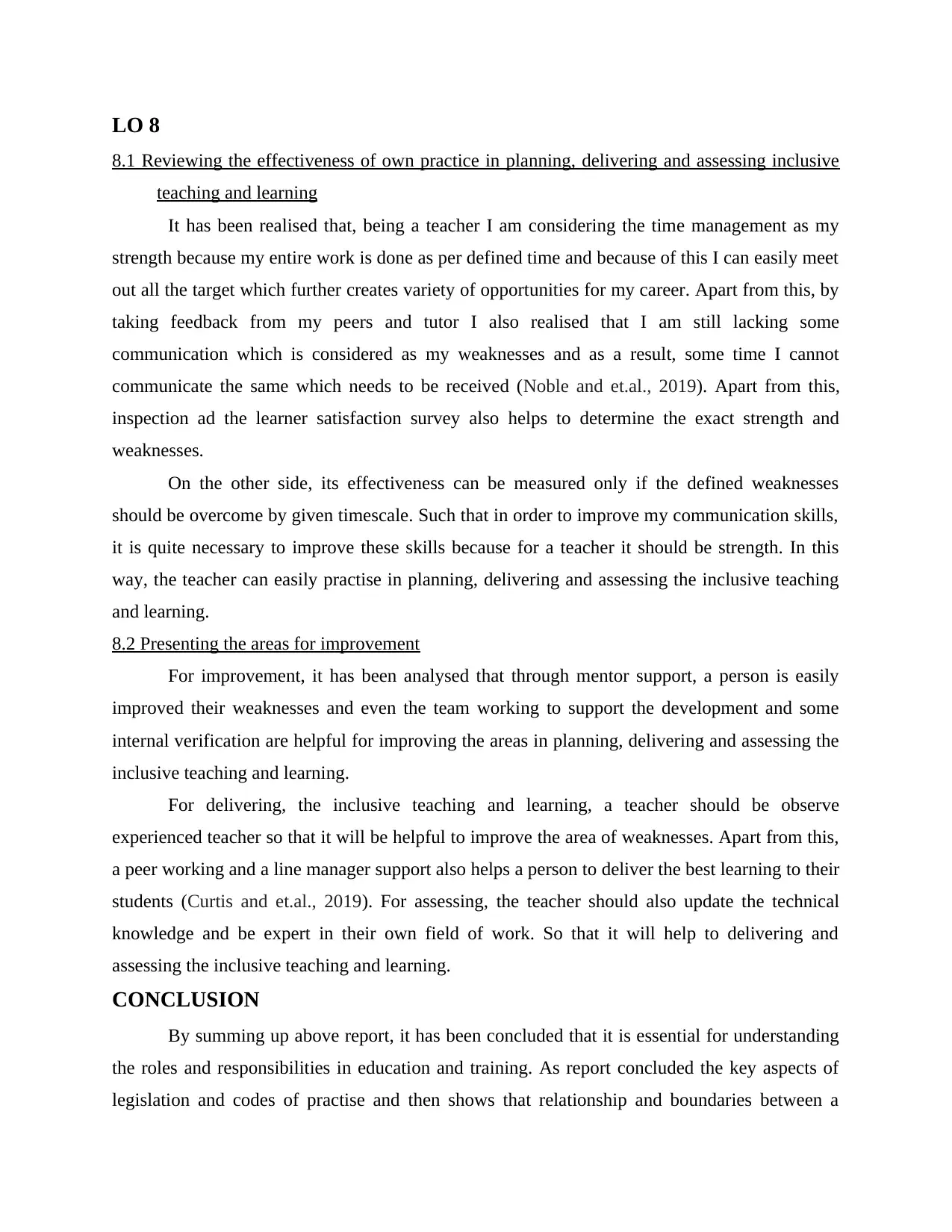
LO 8
8.1 Reviewing the effectiveness of own practice in planning, delivering and assessing inclusive
teaching and learning
It has been realised that, being a teacher I am considering the time management as my
strength because my entire work is done as per defined time and because of this I can easily meet
out all the target which further creates variety of opportunities for my career. Apart from this, by
taking feedback from my peers and tutor I also realised that I am still lacking some
communication which is considered as my weaknesses and as a result, some time I cannot
communicate the same which needs to be received (Noble and et.al., 2019). Apart from this,
inspection ad the learner satisfaction survey also helps to determine the exact strength and
weaknesses.
On the other side, its effectiveness can be measured only if the defined weaknesses
should be overcome by given timescale. Such that in order to improve my communication skills,
it is quite necessary to improve these skills because for a teacher it should be strength. In this
way, the teacher can easily practise in planning, delivering and assessing the inclusive teaching
and learning.
8.2 Presenting the areas for improvement
For improvement, it has been analysed that through mentor support, a person is easily
improved their weaknesses and even the team working to support the development and some
internal verification are helpful for improving the areas in planning, delivering and assessing the
inclusive teaching and learning.
For delivering, the inclusive teaching and learning, a teacher should be observe
experienced teacher so that it will be helpful to improve the area of weaknesses. Apart from this,
a peer working and a line manager support also helps a person to deliver the best learning to their
students (Curtis and et.al., 2019). For assessing, the teacher should also update the technical
knowledge and be expert in their own field of work. So that it will help to delivering and
assessing the inclusive teaching and learning.
CONCLUSION
By summing up above report, it has been concluded that it is essential for understanding
the roles and responsibilities in education and training. As report concluded the key aspects of
legislation and codes of practise and then shows that relationship and boundaries between a
8.1 Reviewing the effectiveness of own practice in planning, delivering and assessing inclusive
teaching and learning
It has been realised that, being a teacher I am considering the time management as my
strength because my entire work is done as per defined time and because of this I can easily meet
out all the target which further creates variety of opportunities for my career. Apart from this, by
taking feedback from my peers and tutor I also realised that I am still lacking some
communication which is considered as my weaknesses and as a result, some time I cannot
communicate the same which needs to be received (Noble and et.al., 2019). Apart from this,
inspection ad the learner satisfaction survey also helps to determine the exact strength and
weaknesses.
On the other side, its effectiveness can be measured only if the defined weaknesses
should be overcome by given timescale. Such that in order to improve my communication skills,
it is quite necessary to improve these skills because for a teacher it should be strength. In this
way, the teacher can easily practise in planning, delivering and assessing the inclusive teaching
and learning.
8.2 Presenting the areas for improvement
For improvement, it has been analysed that through mentor support, a person is easily
improved their weaknesses and even the team working to support the development and some
internal verification are helpful for improving the areas in planning, delivering and assessing the
inclusive teaching and learning.
For delivering, the inclusive teaching and learning, a teacher should be observe
experienced teacher so that it will be helpful to improve the area of weaknesses. Apart from this,
a peer working and a line manager support also helps a person to deliver the best learning to their
students (Curtis and et.al., 2019). For assessing, the teacher should also update the technical
knowledge and be expert in their own field of work. So that it will help to delivering and
assessing the inclusive teaching and learning.
CONCLUSION
By summing up above report, it has been concluded that it is essential for understanding
the roles and responsibilities in education and training. As report concluded the key aspects of
legislation and codes of practise and then shows that relationship and boundaries between a
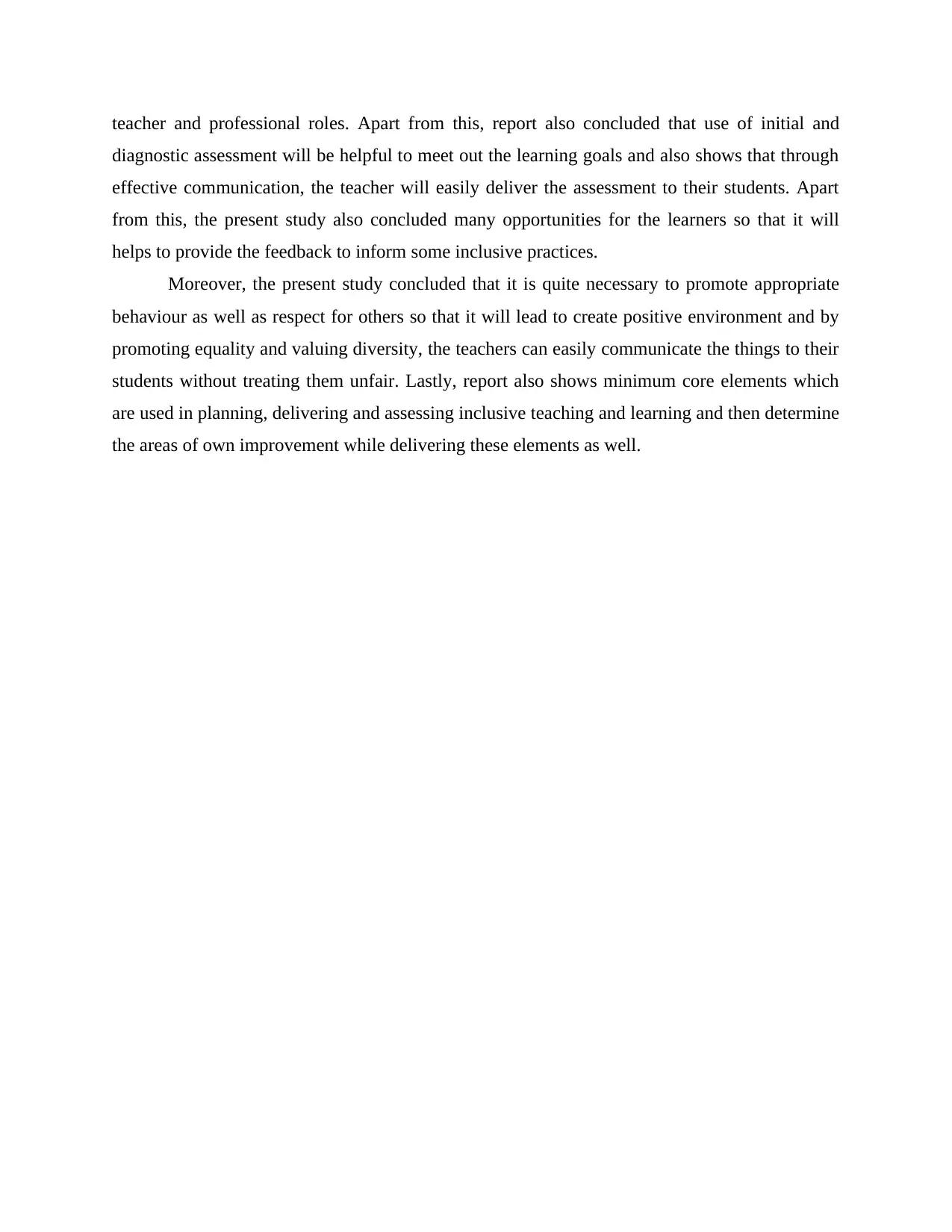
teacher and professional roles. Apart from this, report also concluded that use of initial and
diagnostic assessment will be helpful to meet out the learning goals and also shows that through
effective communication, the teacher will easily deliver the assessment to their students. Apart
from this, the present study also concluded many opportunities for the learners so that it will
helps to provide the feedback to inform some inclusive practices.
Moreover, the present study concluded that it is quite necessary to promote appropriate
behaviour as well as respect for others so that it will lead to create positive environment and by
promoting equality and valuing diversity, the teachers can easily communicate the things to their
students without treating them unfair. Lastly, report also shows minimum core elements which
are used in planning, delivering and assessing inclusive teaching and learning and then determine
the areas of own improvement while delivering these elements as well.
diagnostic assessment will be helpful to meet out the learning goals and also shows that through
effective communication, the teacher will easily deliver the assessment to their students. Apart
from this, the present study also concluded many opportunities for the learners so that it will
helps to provide the feedback to inform some inclusive practices.
Moreover, the present study concluded that it is quite necessary to promote appropriate
behaviour as well as respect for others so that it will lead to create positive environment and by
promoting equality and valuing diversity, the teachers can easily communicate the things to their
students without treating them unfair. Lastly, report also shows minimum core elements which
are used in planning, delivering and assessing inclusive teaching and learning and then determine
the areas of own improvement while delivering these elements as well.
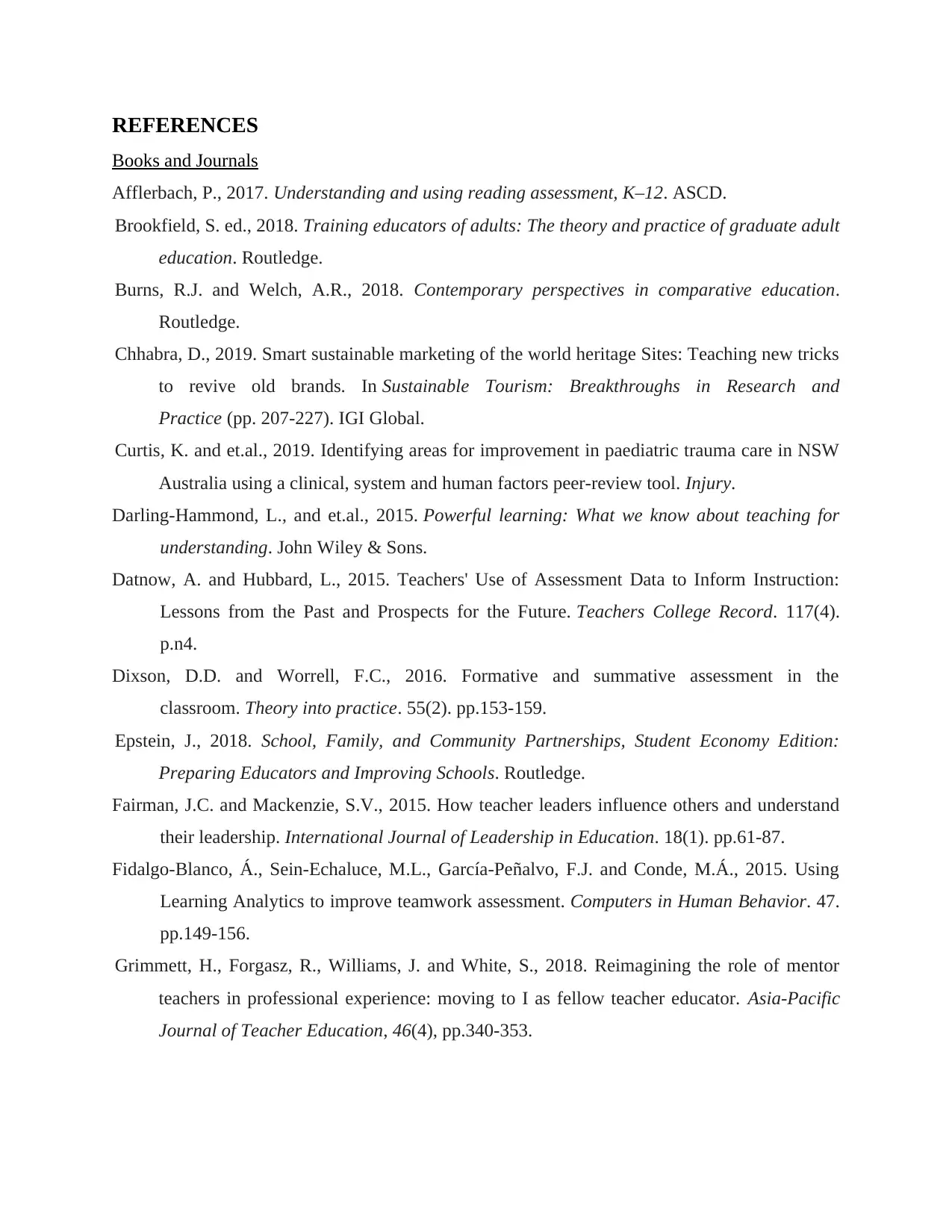
REFERENCES
Books and Journals
Afflerbach, P., 2017. Understanding and using reading assessment, K–12. ASCD.
Brookfield, S. ed., 2018. Training educators of adults: The theory and practice of graduate adult
education. Routledge.
Burns, R.J. and Welch, A.R., 2018. Contemporary perspectives in comparative education.
Routledge.
Chhabra, D., 2019. Smart sustainable marketing of the world heritage Sites: Teaching new tricks
to revive old brands. In Sustainable Tourism: Breakthroughs in Research and
Practice (pp. 207-227). IGI Global.
Curtis, K. and et.al., 2019. Identifying areas for improvement in paediatric trauma care in NSW
Australia using a clinical, system and human factors peer-review tool. Injury.
Darling-Hammond, L., and et.al., 2015. Powerful learning: What we know about teaching for
understanding. John Wiley & Sons.
Datnow, A. and Hubbard, L., 2015. Teachers' Use of Assessment Data to Inform Instruction:
Lessons from the Past and Prospects for the Future. Teachers College Record. 117(4).
p.n4.
Dixson, D.D. and Worrell, F.C., 2016. Formative and summative assessment in the
classroom. Theory into practice. 55(2). pp.153-159.
Epstein, J., 2018. School, Family, and Community Partnerships, Student Economy Edition:
Preparing Educators and Improving Schools. Routledge.
Fairman, J.C. and Mackenzie, S.V., 2015. How teacher leaders influence others and understand
their leadership. International Journal of Leadership in Education. 18(1). pp.61-87.
Fidalgo-Blanco, Á., Sein-Echaluce, M.L., García-Peñalvo, F.J. and Conde, M.Á., 2015. Using
Learning Analytics to improve teamwork assessment. Computers in Human Behavior. 47.
pp.149-156.
Grimmett, H., Forgasz, R., Williams, J. and White, S., 2018. Reimagining the role of mentor
teachers in professional experience: moving to I as fellow teacher educator. Asia-Pacific
Journal of Teacher Education, 46(4), pp.340-353.
Books and Journals
Afflerbach, P., 2017. Understanding and using reading assessment, K–12. ASCD.
Brookfield, S. ed., 2018. Training educators of adults: The theory and practice of graduate adult
education. Routledge.
Burns, R.J. and Welch, A.R., 2018. Contemporary perspectives in comparative education.
Routledge.
Chhabra, D., 2019. Smart sustainable marketing of the world heritage Sites: Teaching new tricks
to revive old brands. In Sustainable Tourism: Breakthroughs in Research and
Practice (pp. 207-227). IGI Global.
Curtis, K. and et.al., 2019. Identifying areas for improvement in paediatric trauma care in NSW
Australia using a clinical, system and human factors peer-review tool. Injury.
Darling-Hammond, L., and et.al., 2015. Powerful learning: What we know about teaching for
understanding. John Wiley & Sons.
Datnow, A. and Hubbard, L., 2015. Teachers' Use of Assessment Data to Inform Instruction:
Lessons from the Past and Prospects for the Future. Teachers College Record. 117(4).
p.n4.
Dixson, D.D. and Worrell, F.C., 2016. Formative and summative assessment in the
classroom. Theory into practice. 55(2). pp.153-159.
Epstein, J., 2018. School, Family, and Community Partnerships, Student Economy Edition:
Preparing Educators and Improving Schools. Routledge.
Fairman, J.C. and Mackenzie, S.V., 2015. How teacher leaders influence others and understand
their leadership. International Journal of Leadership in Education. 18(1). pp.61-87.
Fidalgo-Blanco, Á., Sein-Echaluce, M.L., García-Peñalvo, F.J. and Conde, M.Á., 2015. Using
Learning Analytics to improve teamwork assessment. Computers in Human Behavior. 47.
pp.149-156.
Grimmett, H., Forgasz, R., Williams, J. and White, S., 2018. Reimagining the role of mentor
teachers in professional experience: moving to I as fellow teacher educator. Asia-Pacific
Journal of Teacher Education, 46(4), pp.340-353.
Paraphrase This Document
Need a fresh take? Get an instant paraphrase of this document with our AI Paraphraser
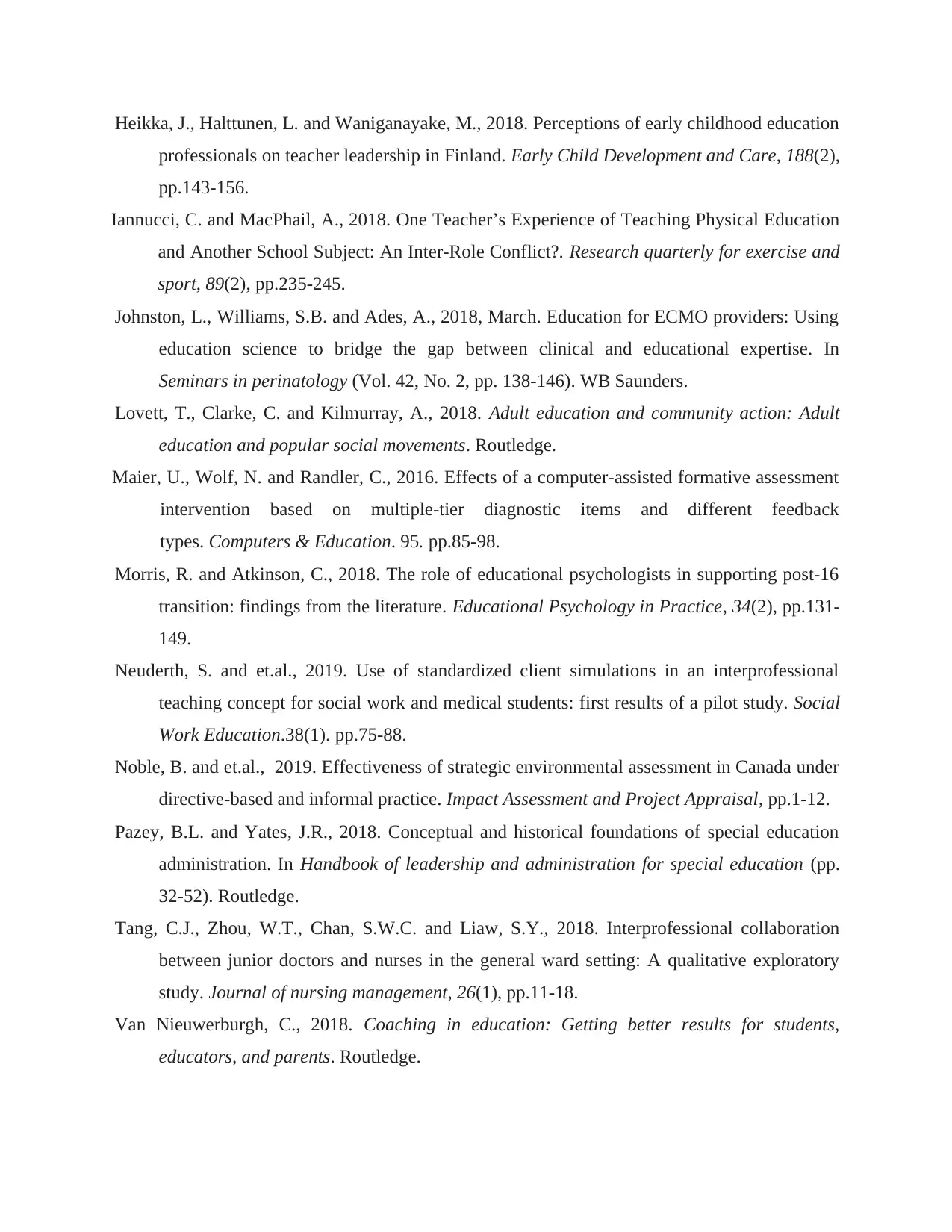
Heikka, J., Halttunen, L. and Waniganayake, M., 2018. Perceptions of early childhood education
professionals on teacher leadership in Finland. Early Child Development and Care, 188(2),
pp.143-156.
Iannucci, C. and MacPhail, A., 2018. One Teacher’s Experience of Teaching Physical Education
and Another School Subject: An Inter-Role Conflict?. Research quarterly for exercise and
sport, 89(2), pp.235-245.
Johnston, L., Williams, S.B. and Ades, A., 2018, March. Education for ECMO providers: Using
education science to bridge the gap between clinical and educational expertise. In
Seminars in perinatology (Vol. 42, No. 2, pp. 138-146). WB Saunders.
Lovett, T., Clarke, C. and Kilmurray, A., 2018. Adult education and community action: Adult
education and popular social movements. Routledge.
Maier, U., Wolf, N. and Randler, C., 2016. Effects of a computer-assisted formative assessment
intervention based on multiple-tier diagnostic items and different feedback
types. Computers & Education. 95. pp.85-98.
Morris, R. and Atkinson, C., 2018. The role of educational psychologists in supporting post-16
transition: findings from the literature. Educational Psychology in Practice, 34(2), pp.131-
149.
Neuderth, S. and et.al., 2019. Use of standardized client simulations in an interprofessional
teaching concept for social work and medical students: first results of a pilot study. Social
Work Education.38(1). pp.75-88.
Noble, B. and et.al., 2019. Effectiveness of strategic environmental assessment in Canada under
directive-based and informal practice. Impact Assessment and Project Appraisal, pp.1-12.
Pazey, B.L. and Yates, J.R., 2018. Conceptual and historical foundations of special education
administration. In Handbook of leadership and administration for special education (pp.
32-52). Routledge.
Tang, C.J., Zhou, W.T., Chan, S.W.C. and Liaw, S.Y., 2018. Interprofessional collaboration
between junior doctors and nurses in the general ward setting: A qualitative exploratory
study. Journal of nursing management, 26(1), pp.11-18.
Van Nieuwerburgh, C., 2018. Coaching in education: Getting better results for students,
educators, and parents. Routledge.
professionals on teacher leadership in Finland. Early Child Development and Care, 188(2),
pp.143-156.
Iannucci, C. and MacPhail, A., 2018. One Teacher’s Experience of Teaching Physical Education
and Another School Subject: An Inter-Role Conflict?. Research quarterly for exercise and
sport, 89(2), pp.235-245.
Johnston, L., Williams, S.B. and Ades, A., 2018, March. Education for ECMO providers: Using
education science to bridge the gap between clinical and educational expertise. In
Seminars in perinatology (Vol. 42, No. 2, pp. 138-146). WB Saunders.
Lovett, T., Clarke, C. and Kilmurray, A., 2018. Adult education and community action: Adult
education and popular social movements. Routledge.
Maier, U., Wolf, N. and Randler, C., 2016. Effects of a computer-assisted formative assessment
intervention based on multiple-tier diagnostic items and different feedback
types. Computers & Education. 95. pp.85-98.
Morris, R. and Atkinson, C., 2018. The role of educational psychologists in supporting post-16
transition: findings from the literature. Educational Psychology in Practice, 34(2), pp.131-
149.
Neuderth, S. and et.al., 2019. Use of standardized client simulations in an interprofessional
teaching concept for social work and medical students: first results of a pilot study. Social
Work Education.38(1). pp.75-88.
Noble, B. and et.al., 2019. Effectiveness of strategic environmental assessment in Canada under
directive-based and informal practice. Impact Assessment and Project Appraisal, pp.1-12.
Pazey, B.L. and Yates, J.R., 2018. Conceptual and historical foundations of special education
administration. In Handbook of leadership and administration for special education (pp.
32-52). Routledge.
Tang, C.J., Zhou, W.T., Chan, S.W.C. and Liaw, S.Y., 2018. Interprofessional collaboration
between junior doctors and nurses in the general ward setting: A qualitative exploratory
study. Journal of nursing management, 26(1), pp.11-18.
Van Nieuwerburgh, C., 2018. Coaching in education: Getting better results for students,
educators, and parents. Routledge.
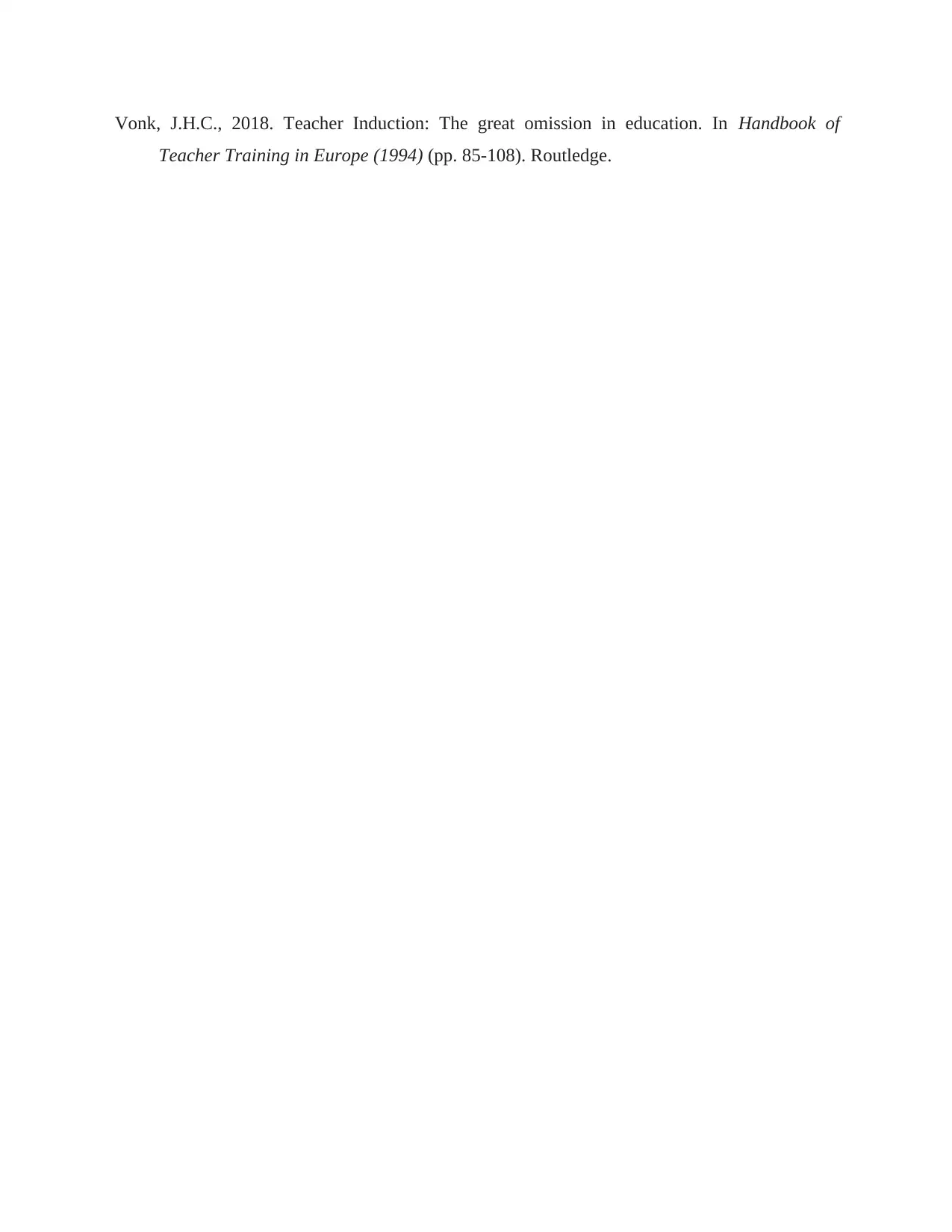
Vonk, J.H.C., 2018. Teacher Induction: The great omission in education. In Handbook of
Teacher Training in Europe (1994) (pp. 85-108). Routledge.
Teacher Training in Europe (1994) (pp. 85-108). Routledge.
1 out of 33
Related Documents
Your All-in-One AI-Powered Toolkit for Academic Success.
+13062052269
info@desklib.com
Available 24*7 on WhatsApp / Email
![[object Object]](/_next/static/media/star-bottom.7253800d.svg)
Unlock your academic potential
© 2024 | Zucol Services PVT LTD | All rights reserved.



